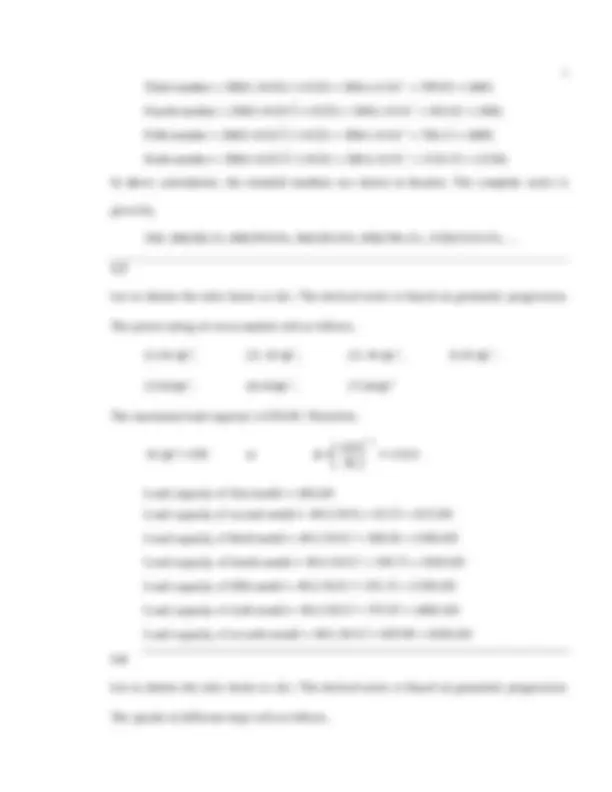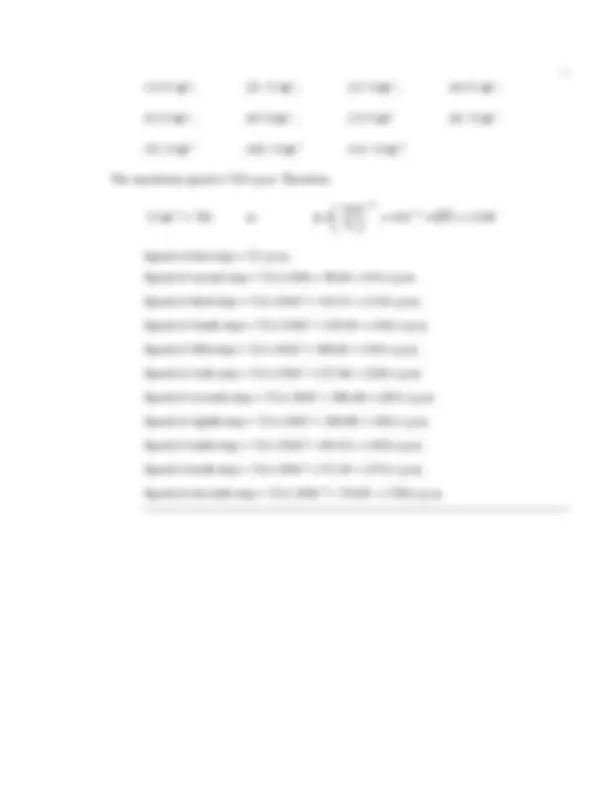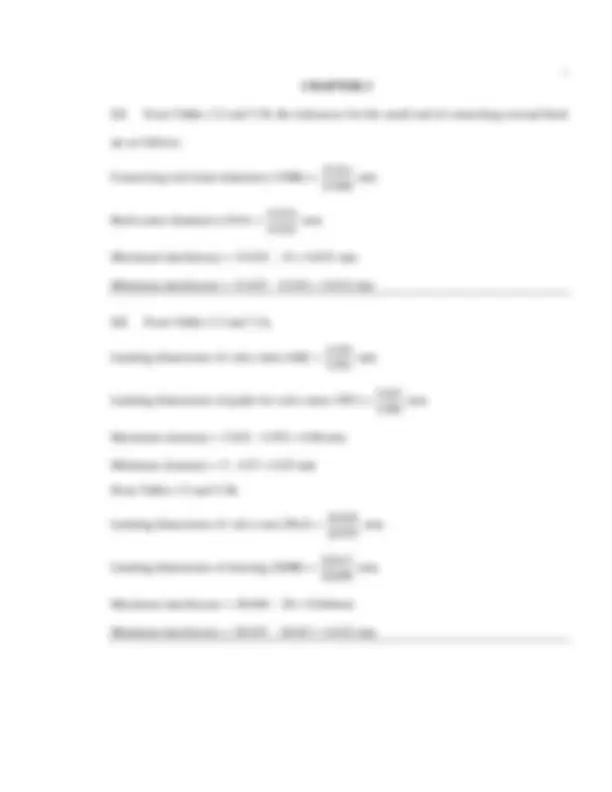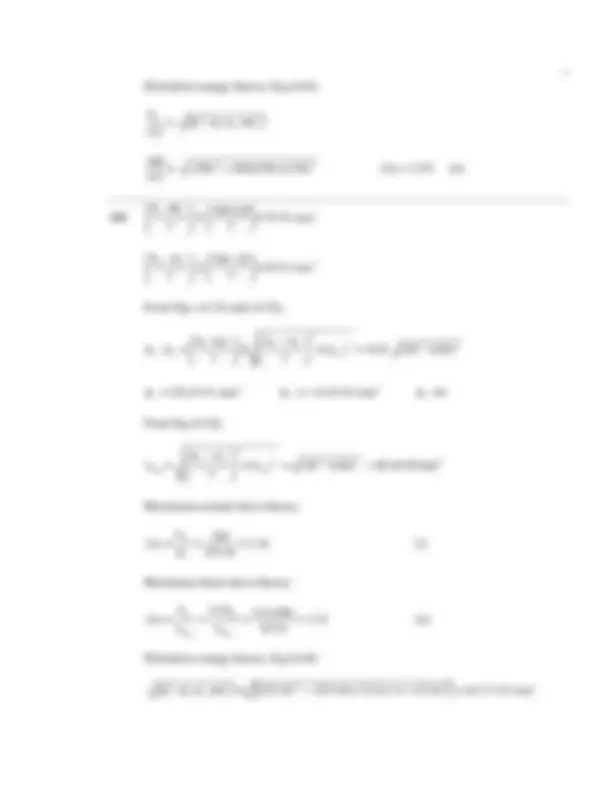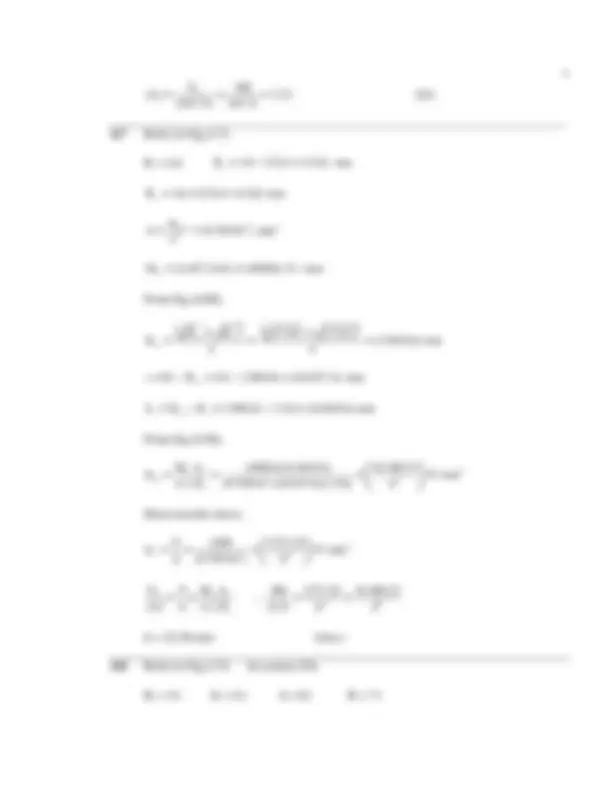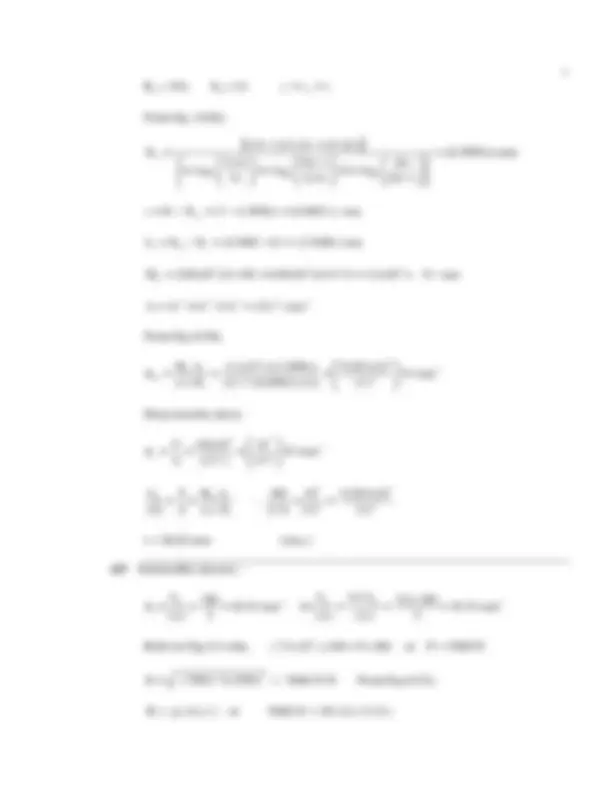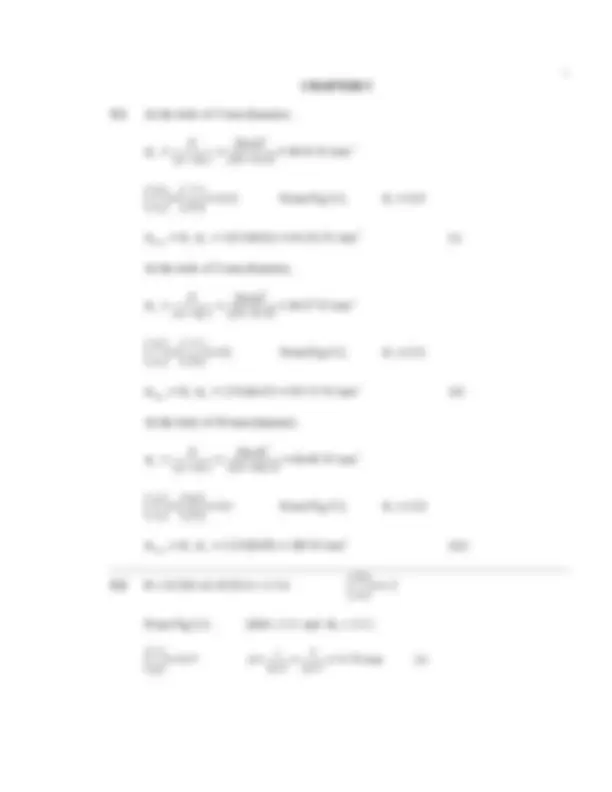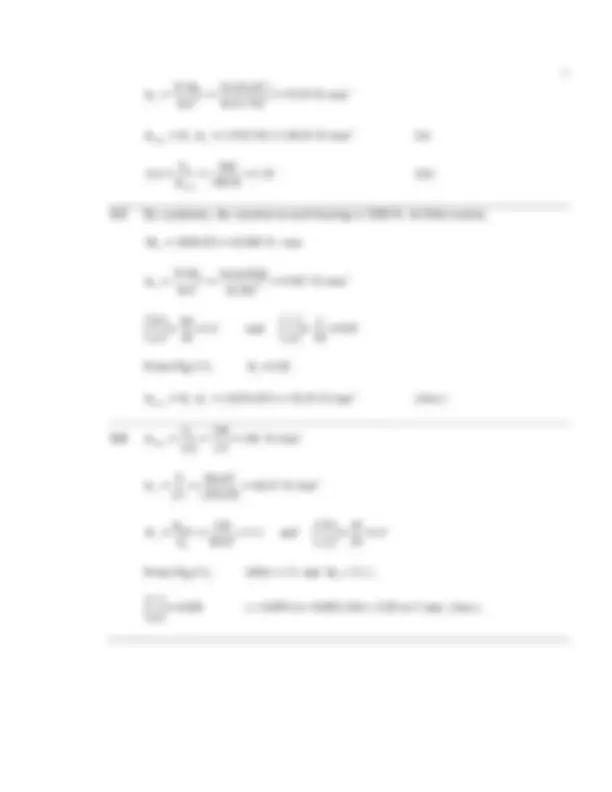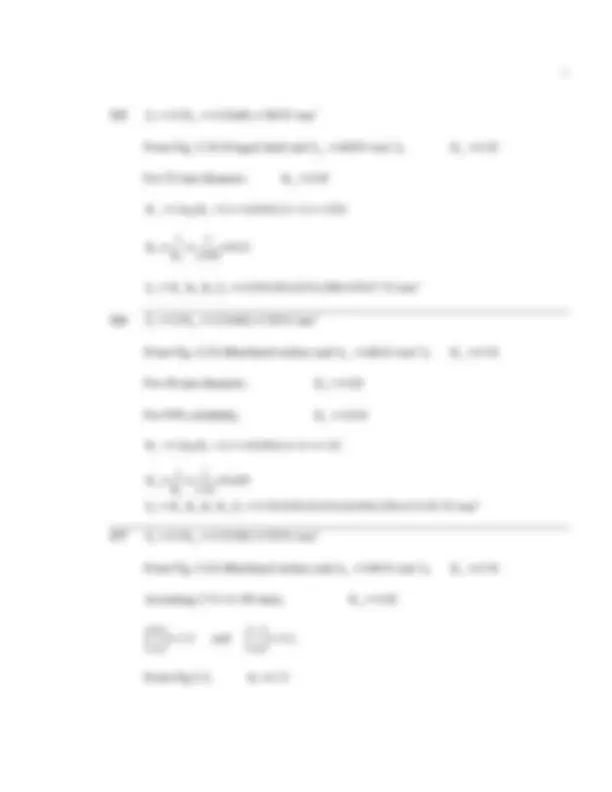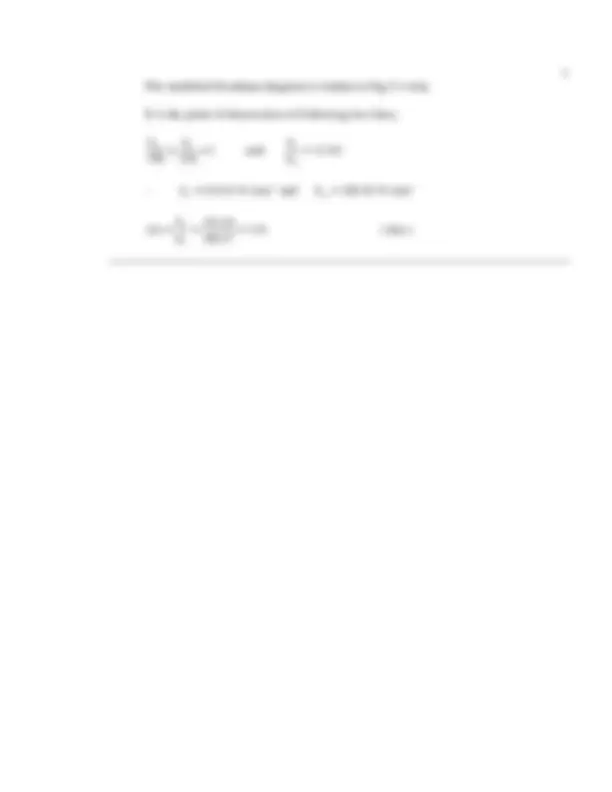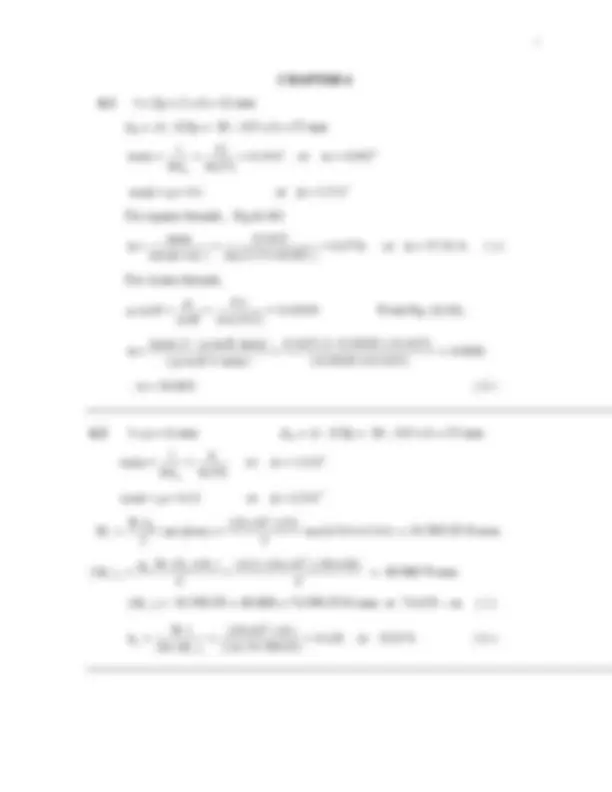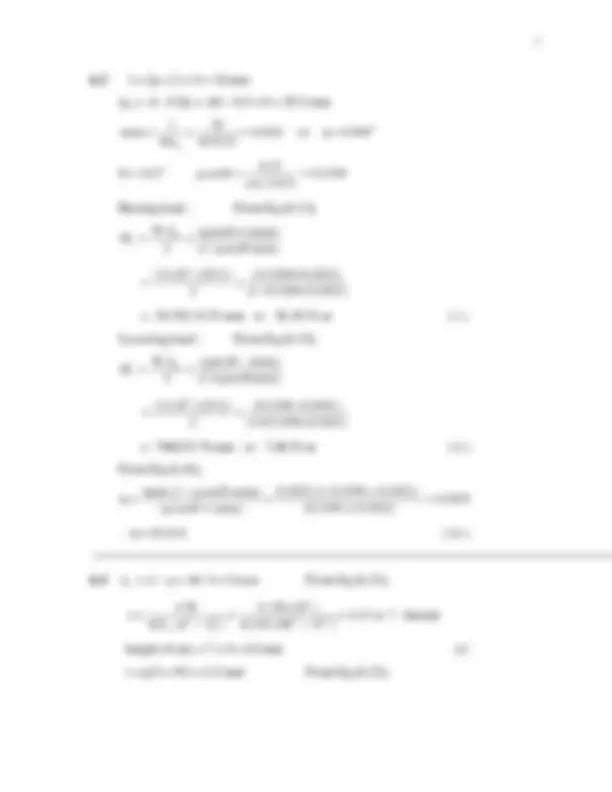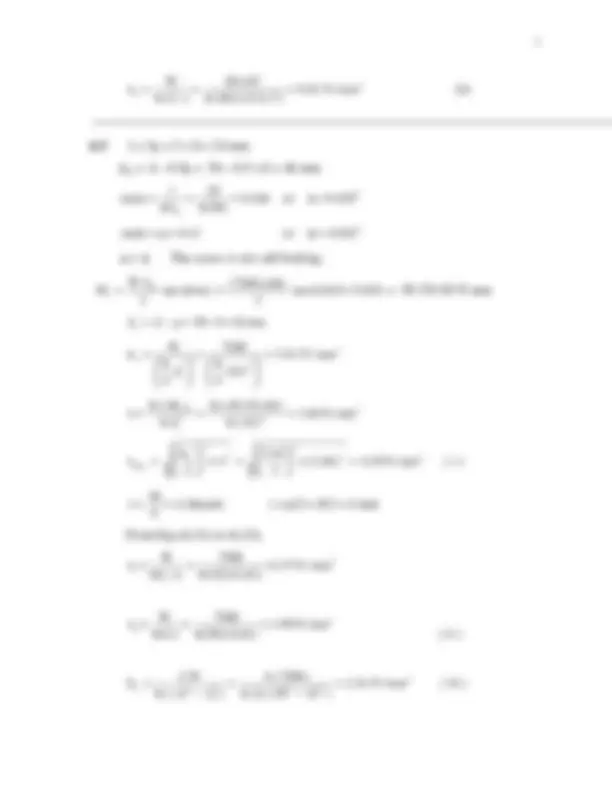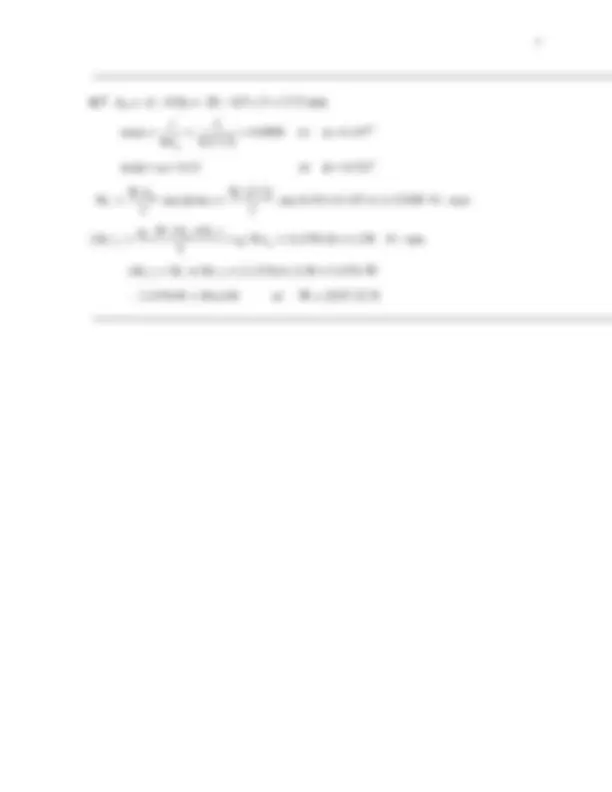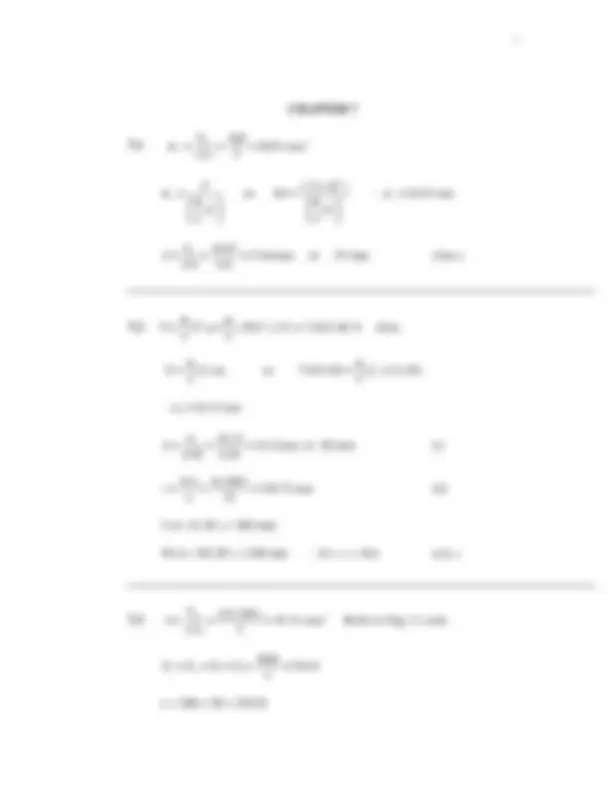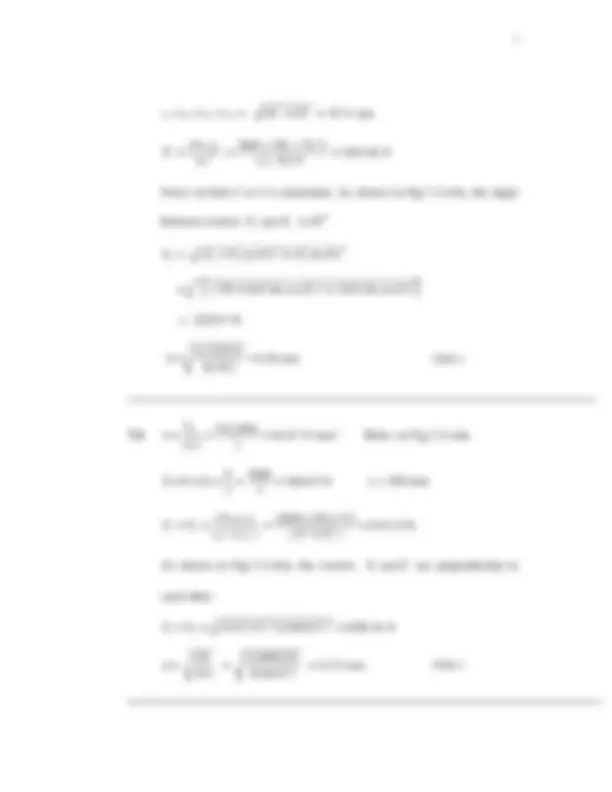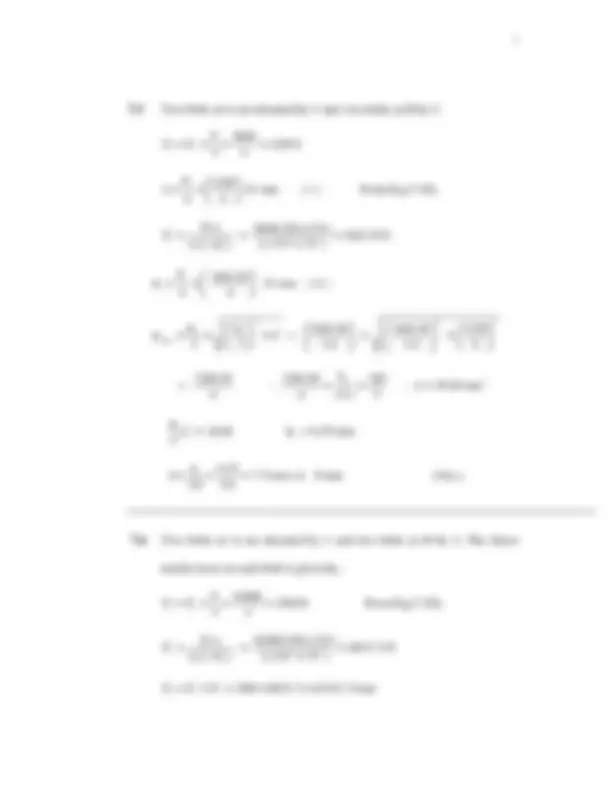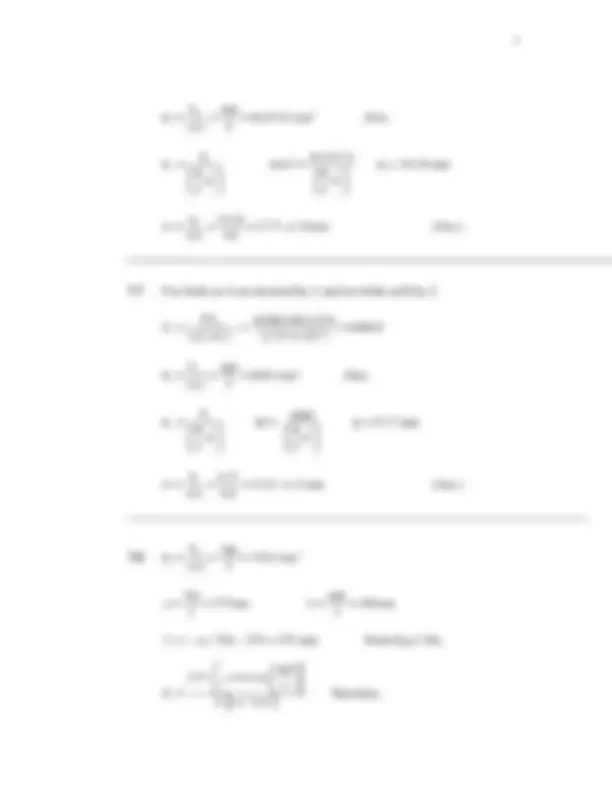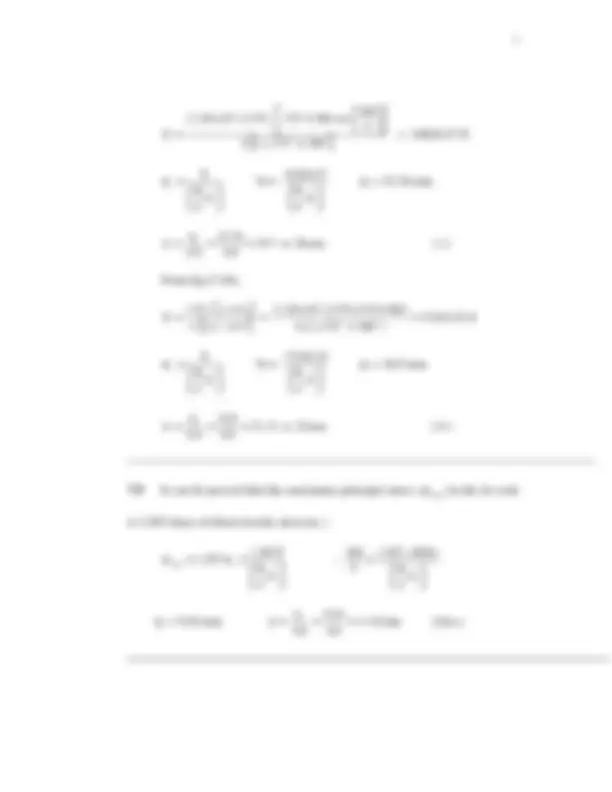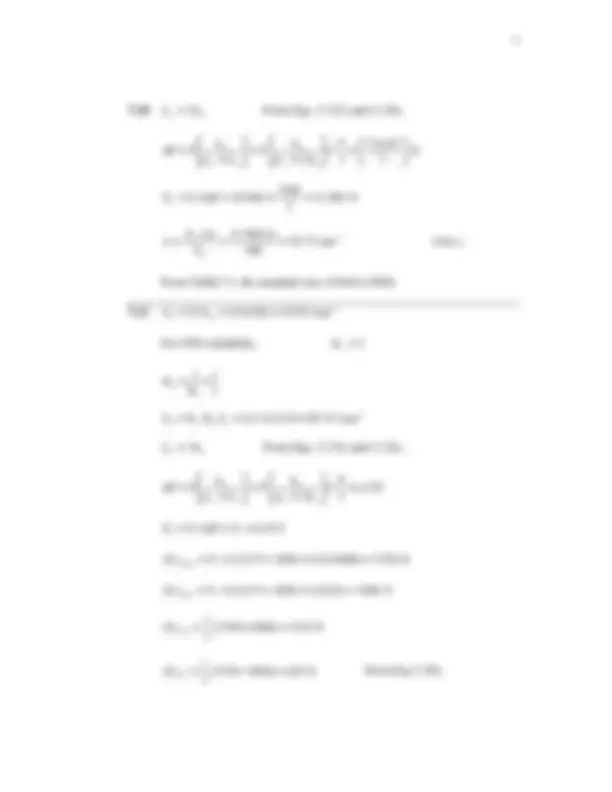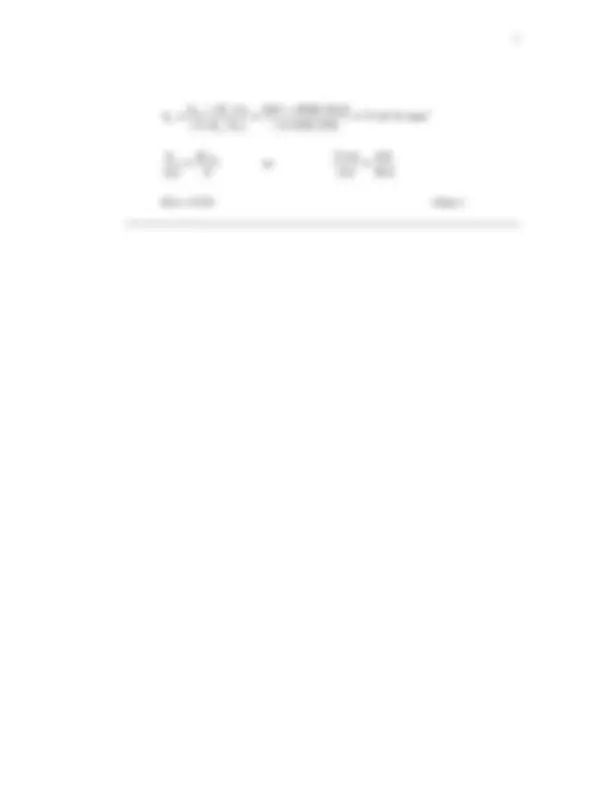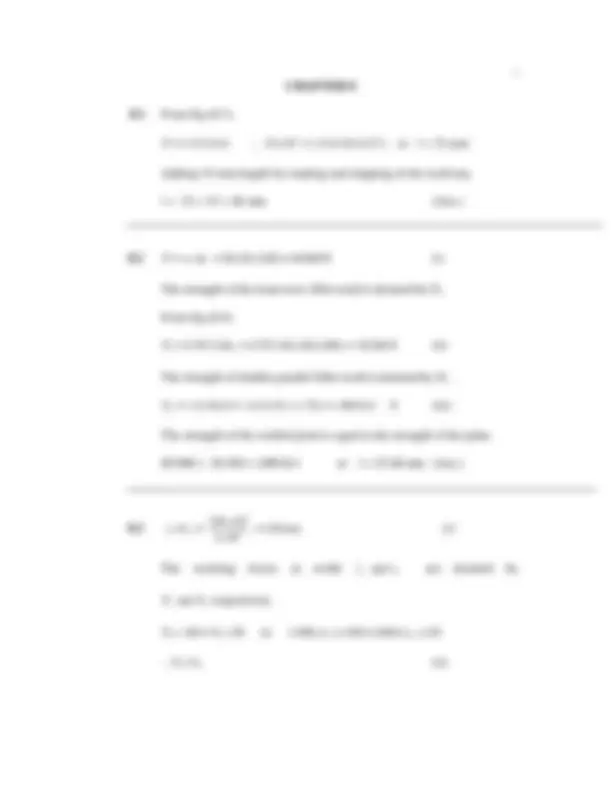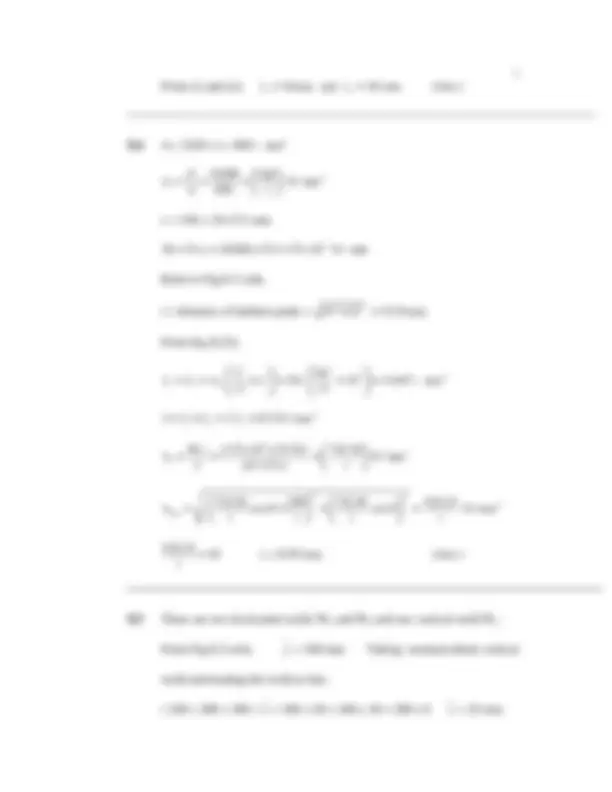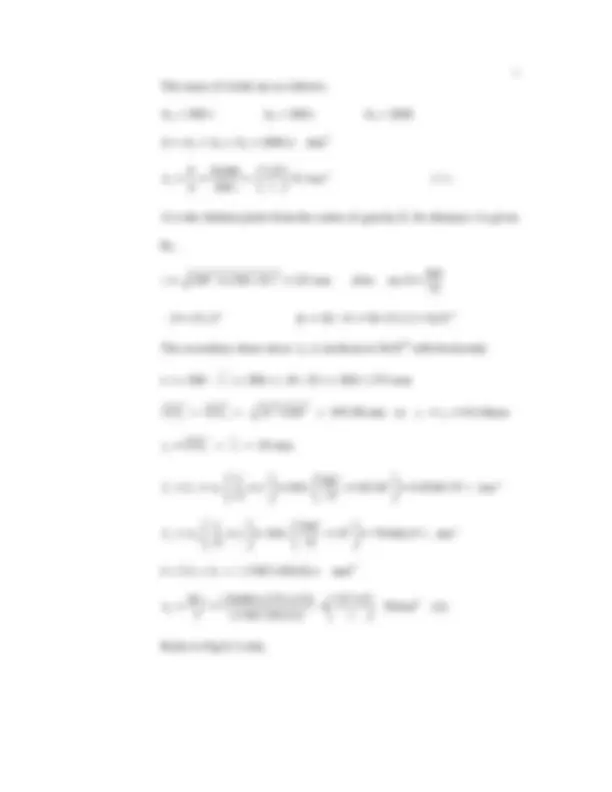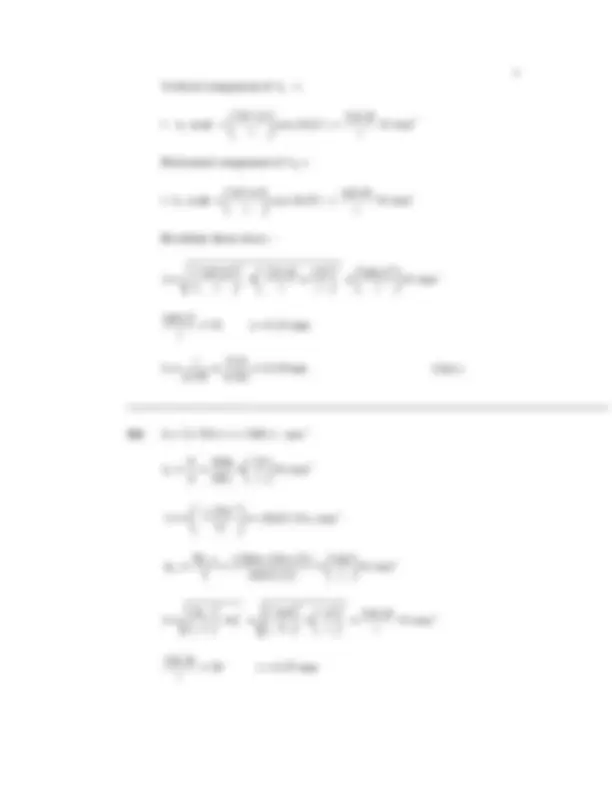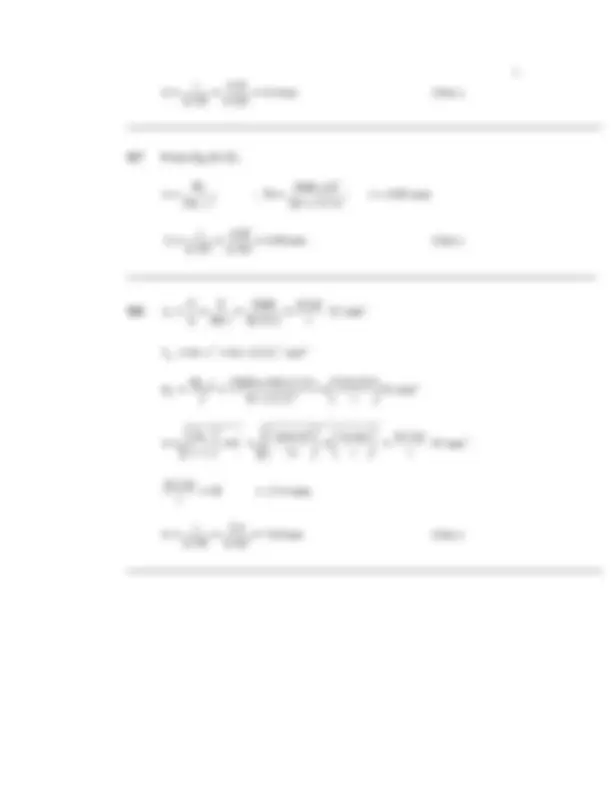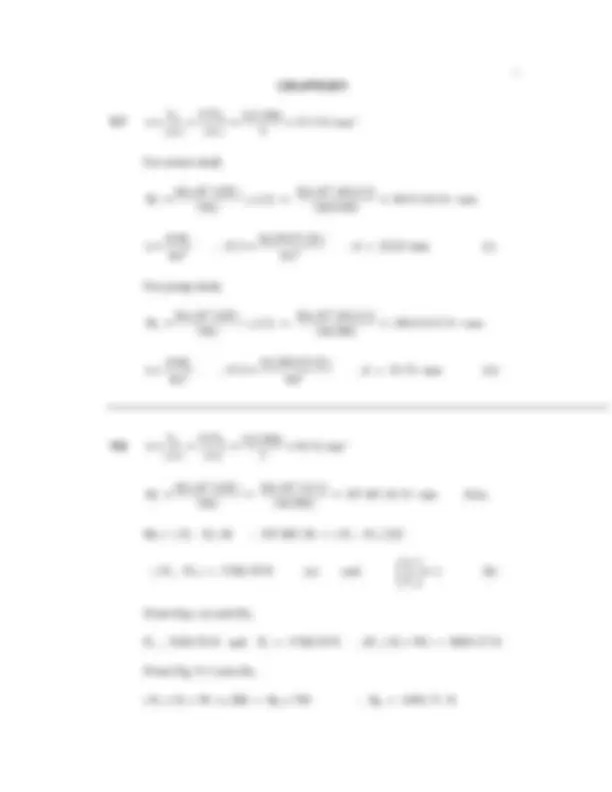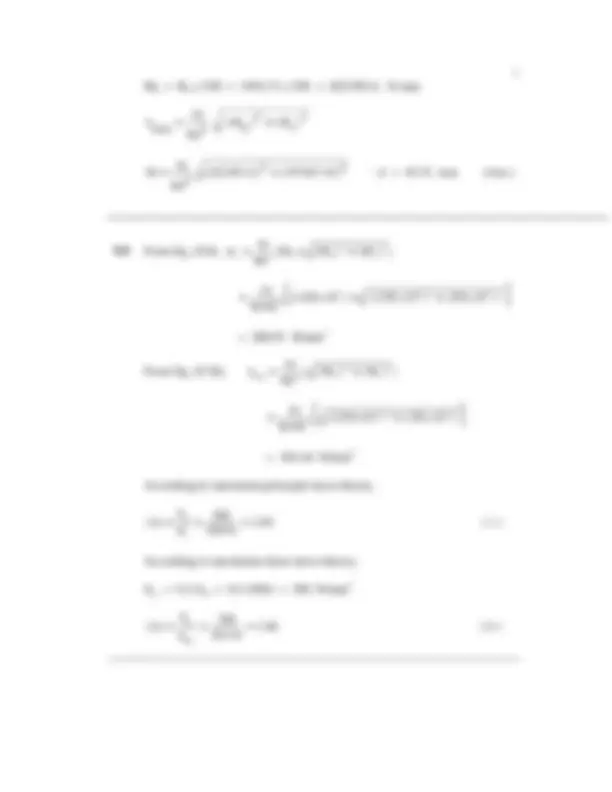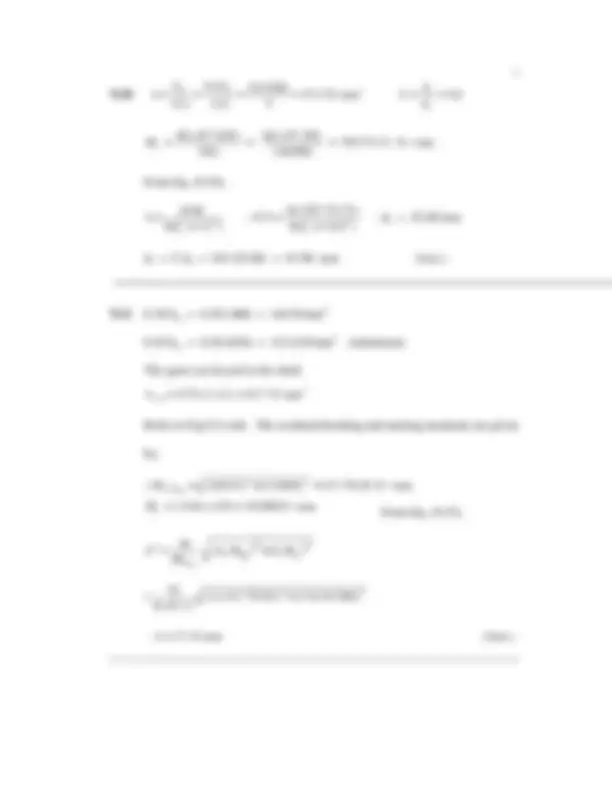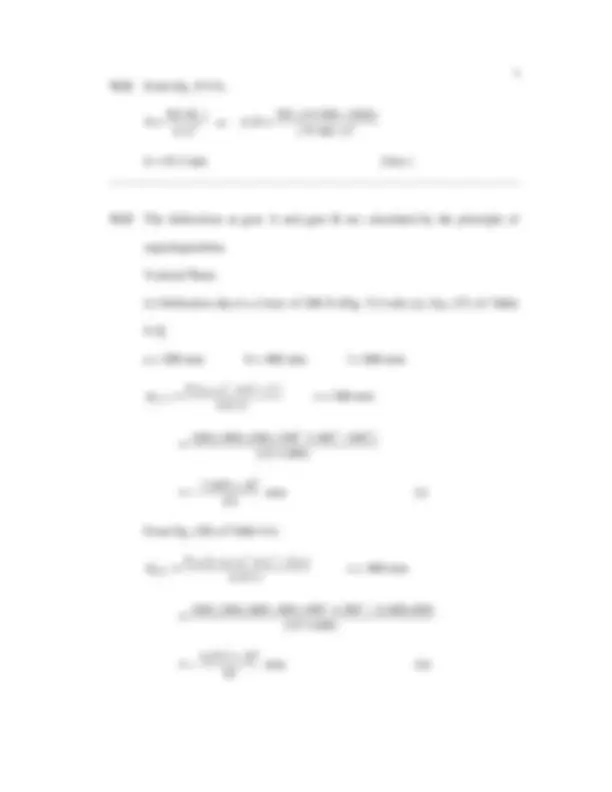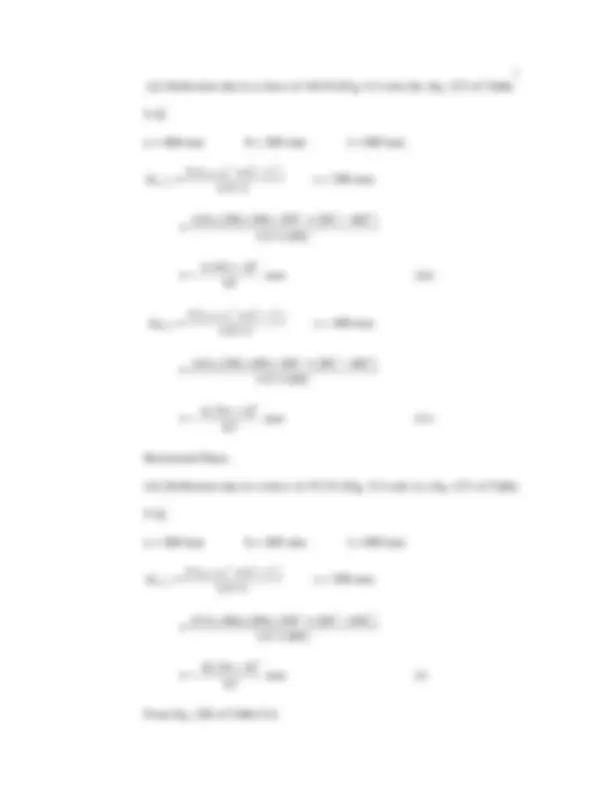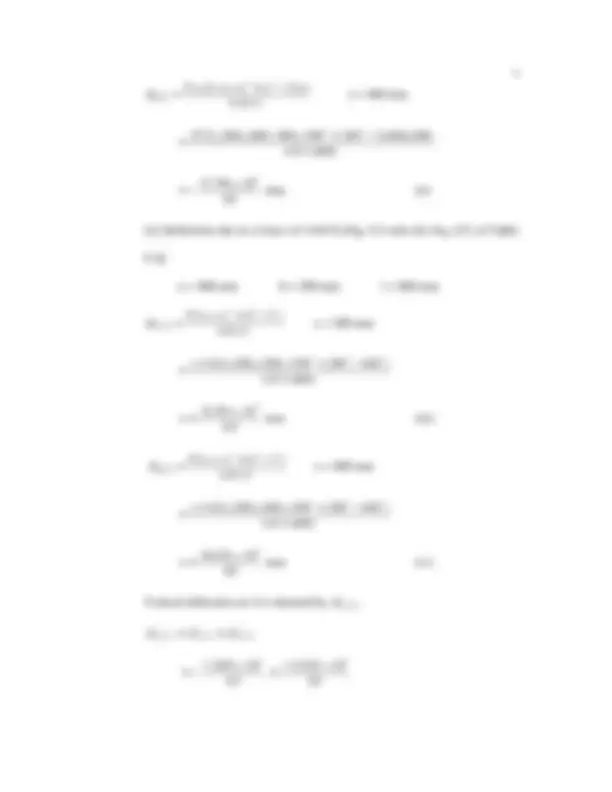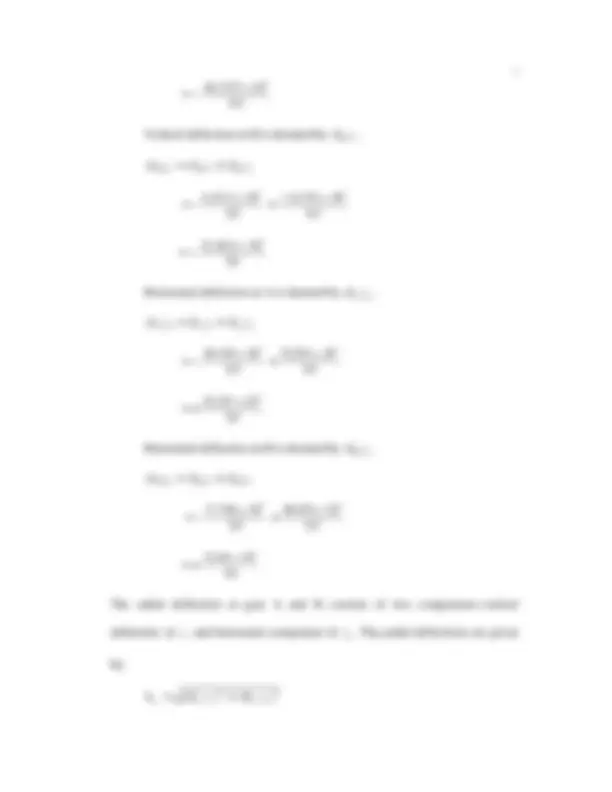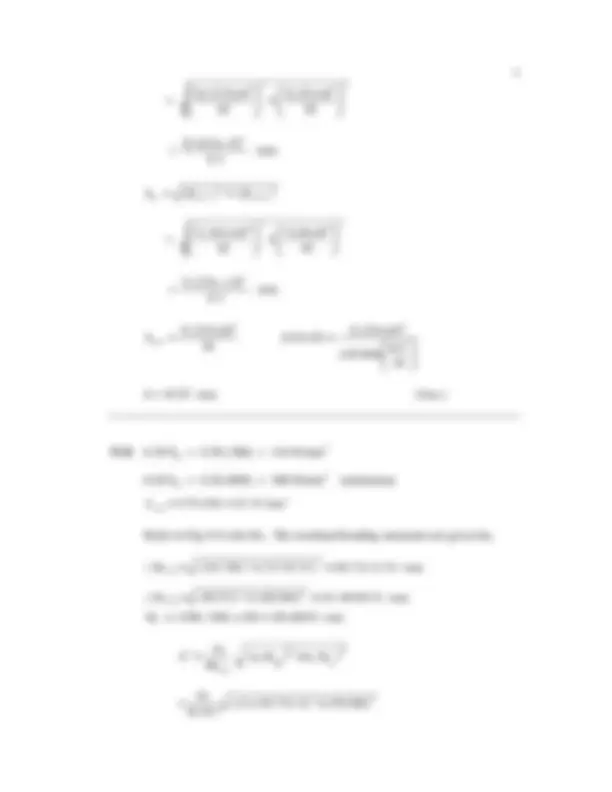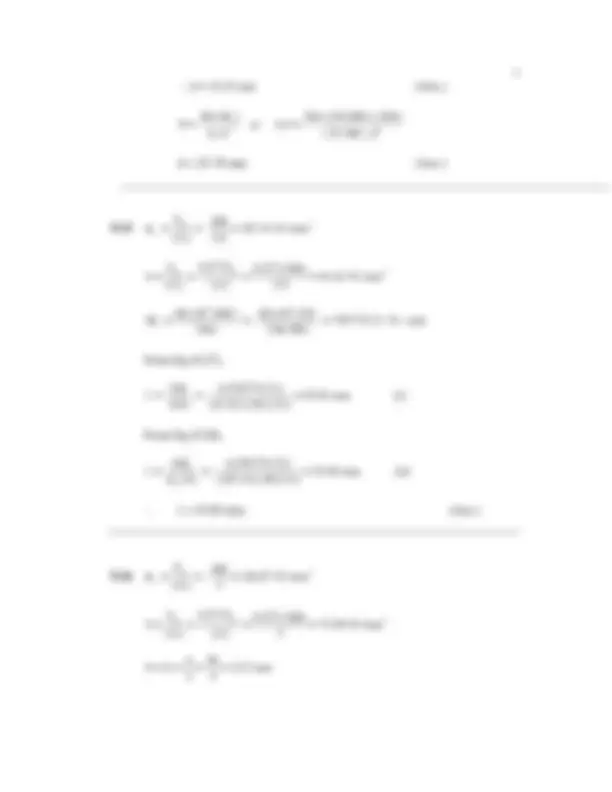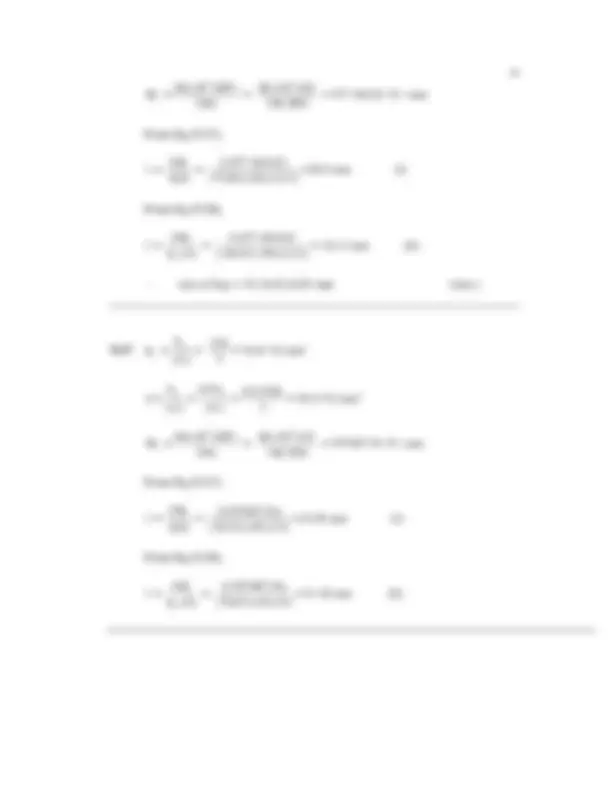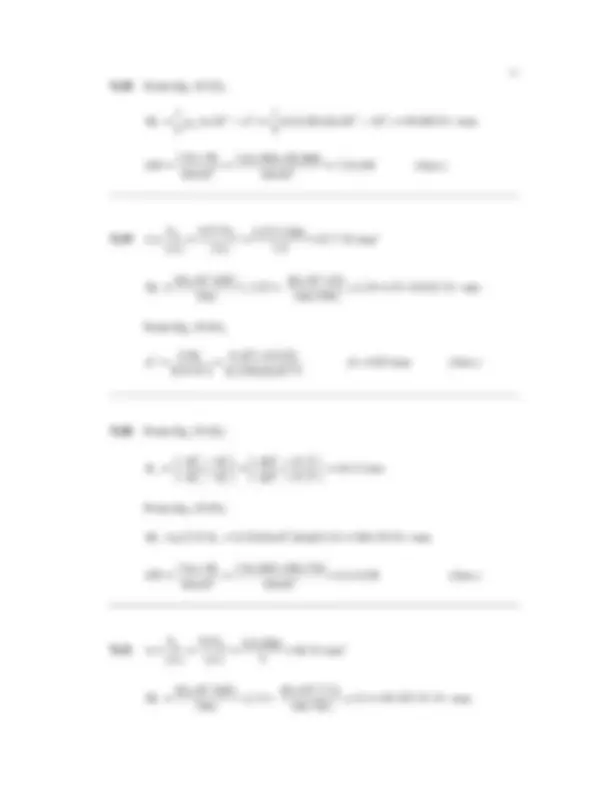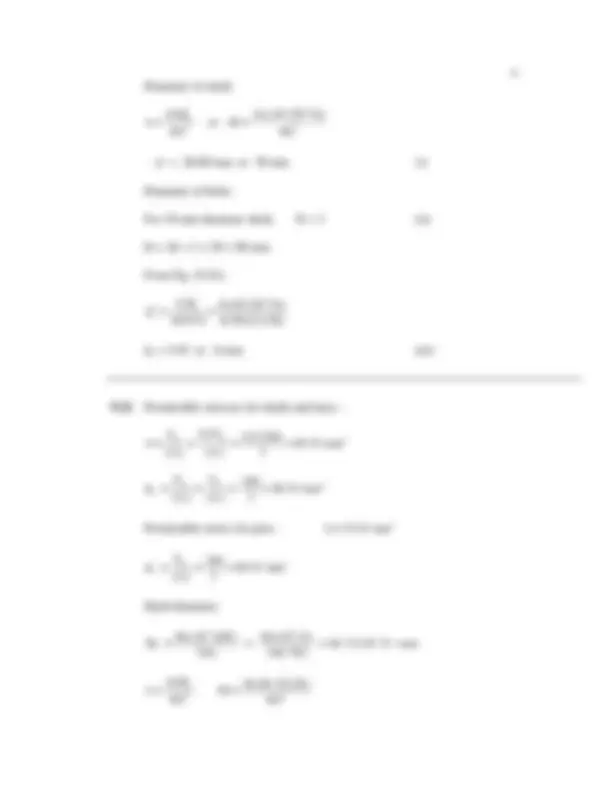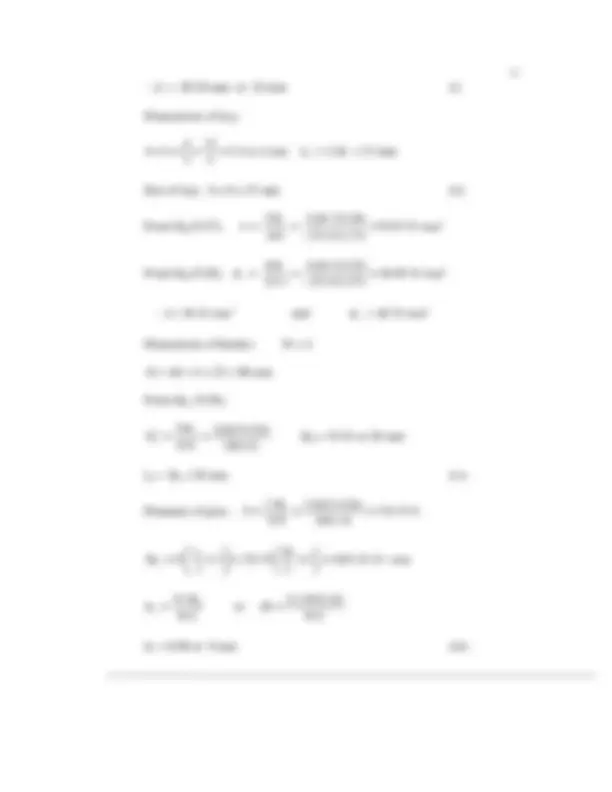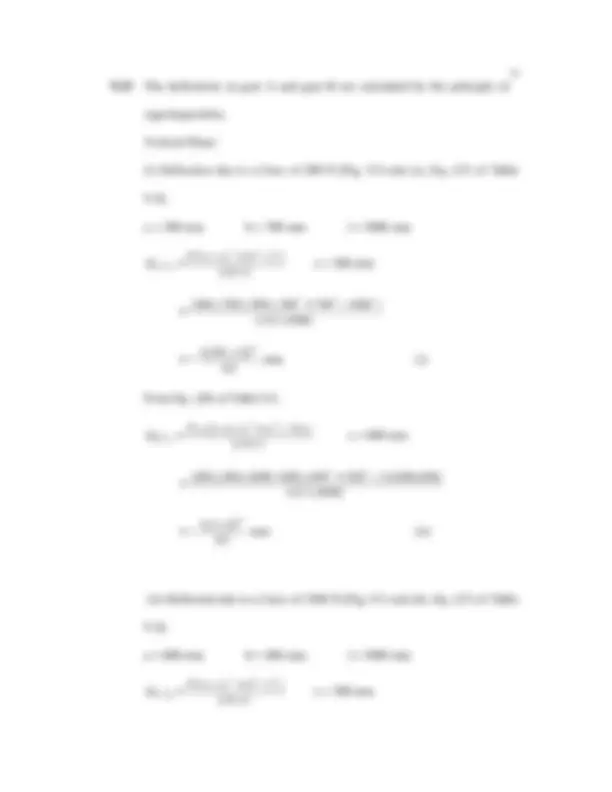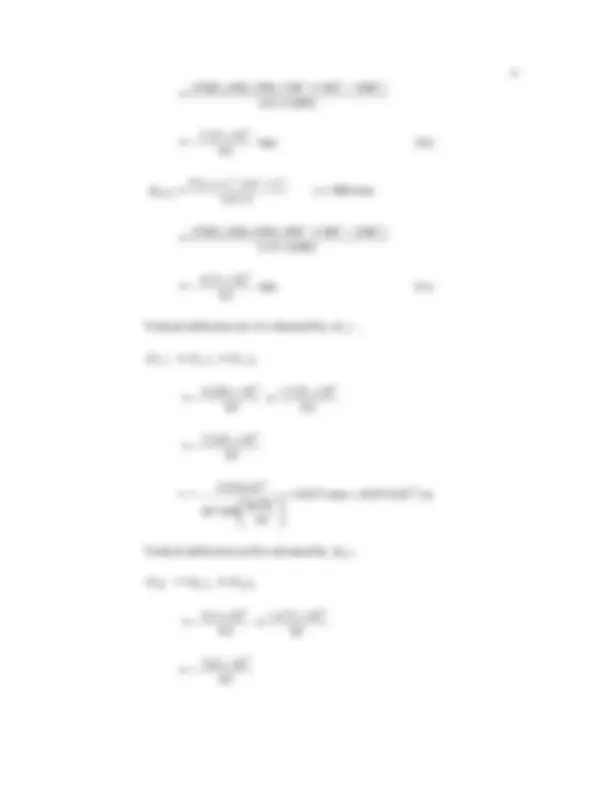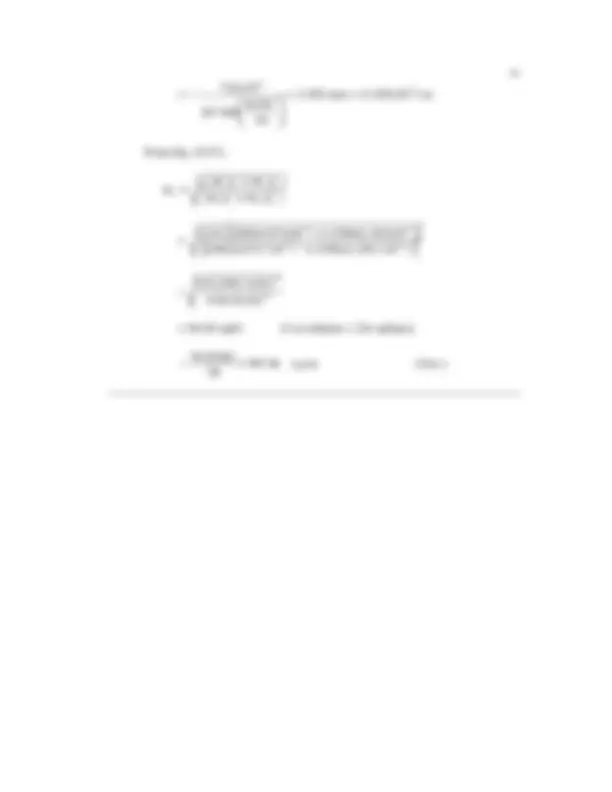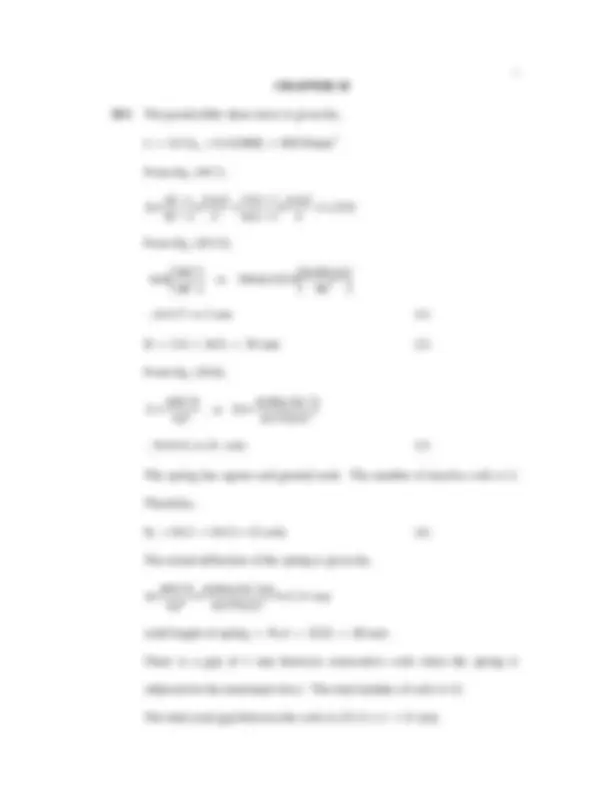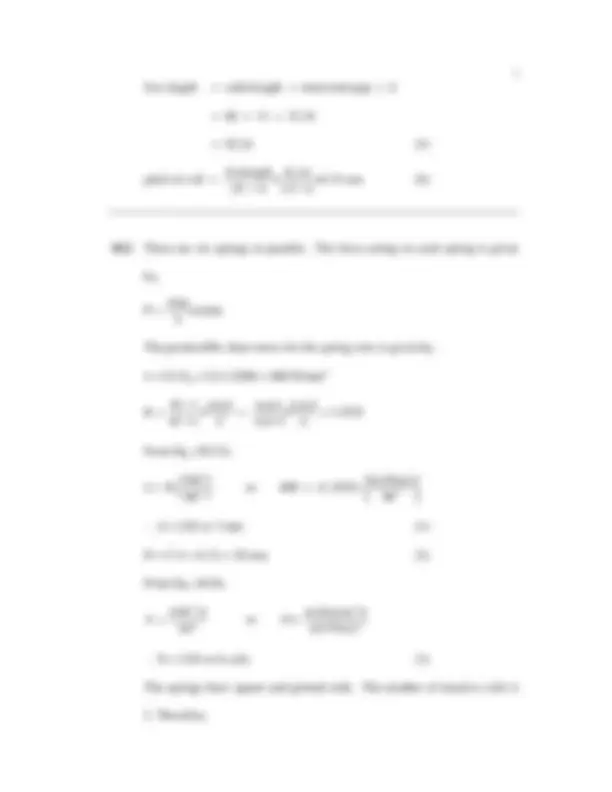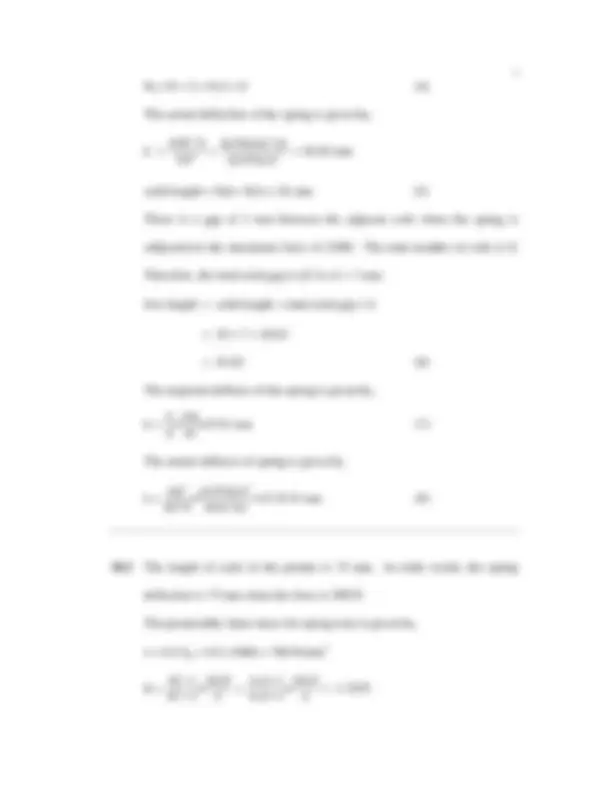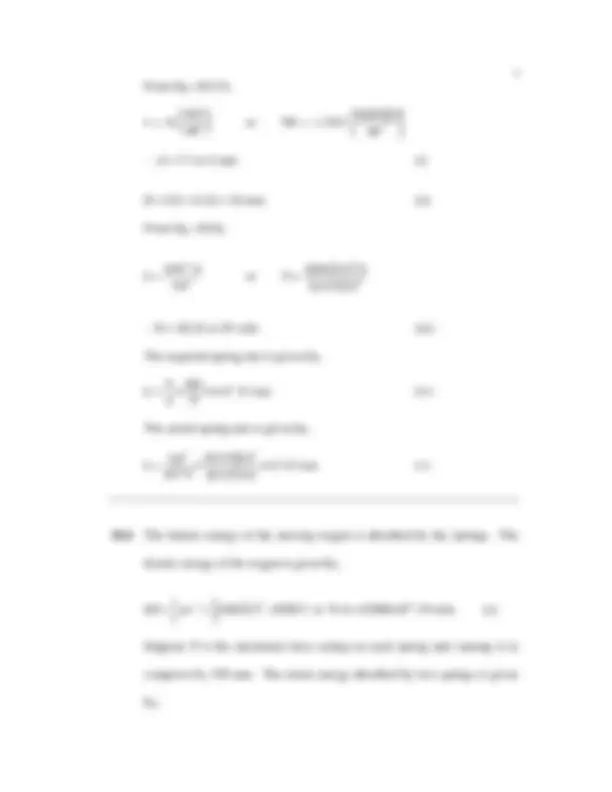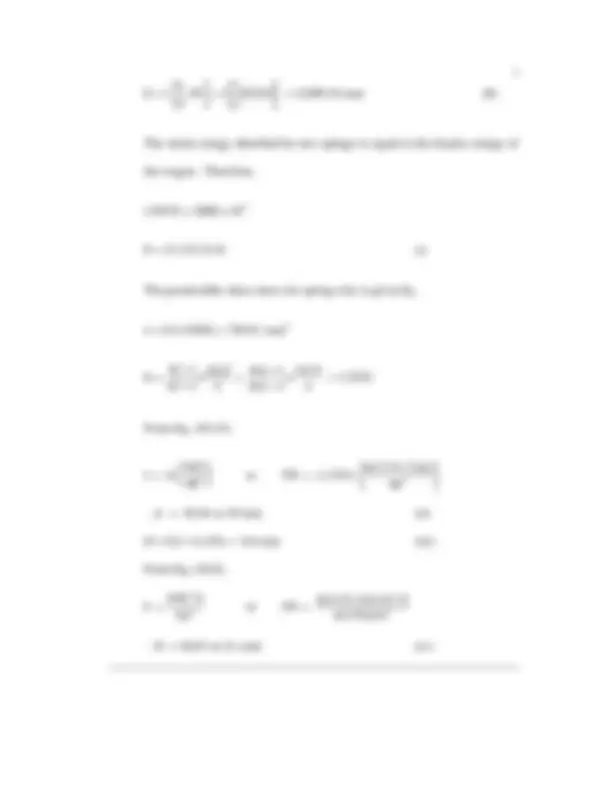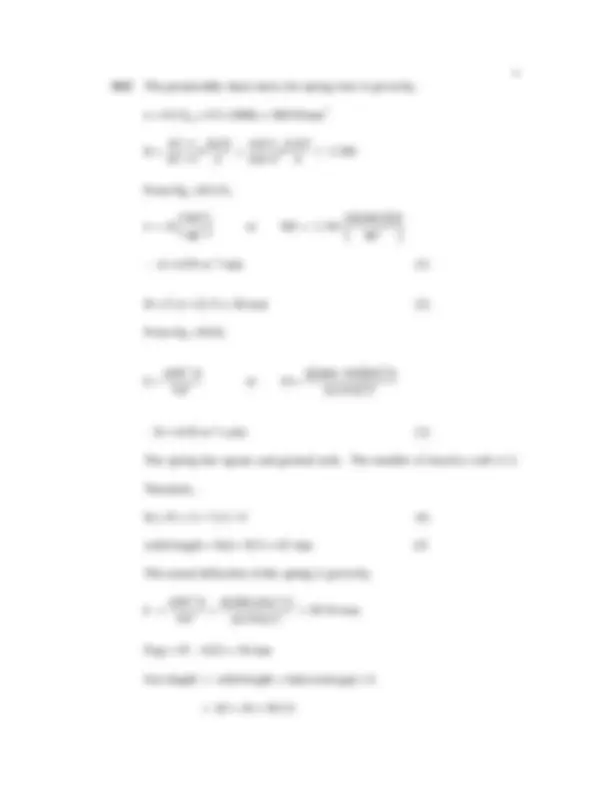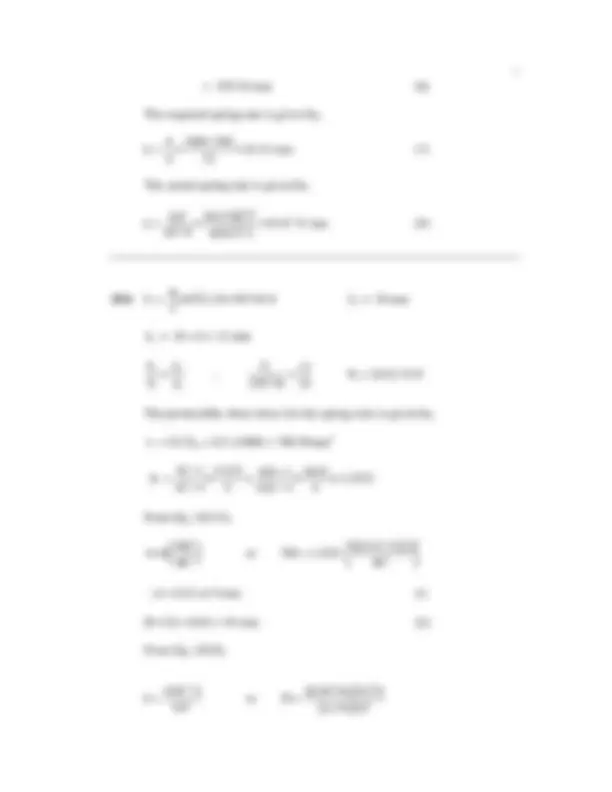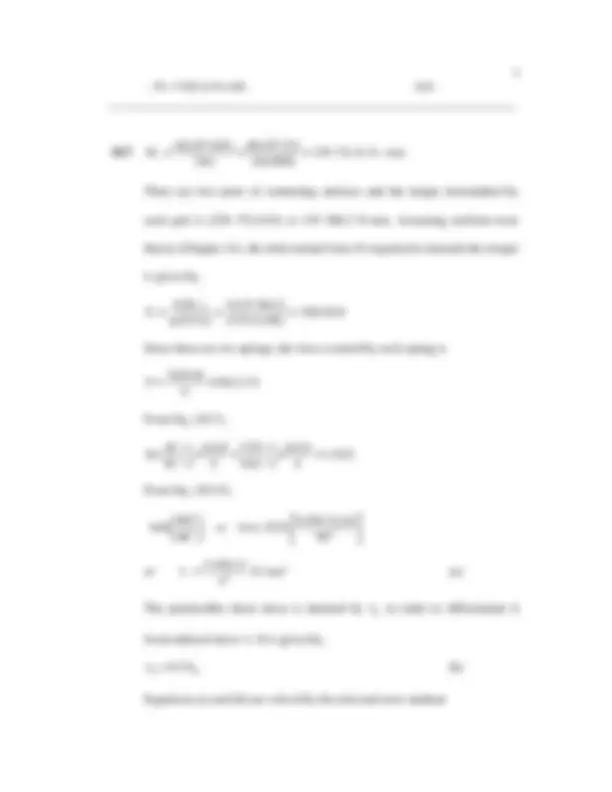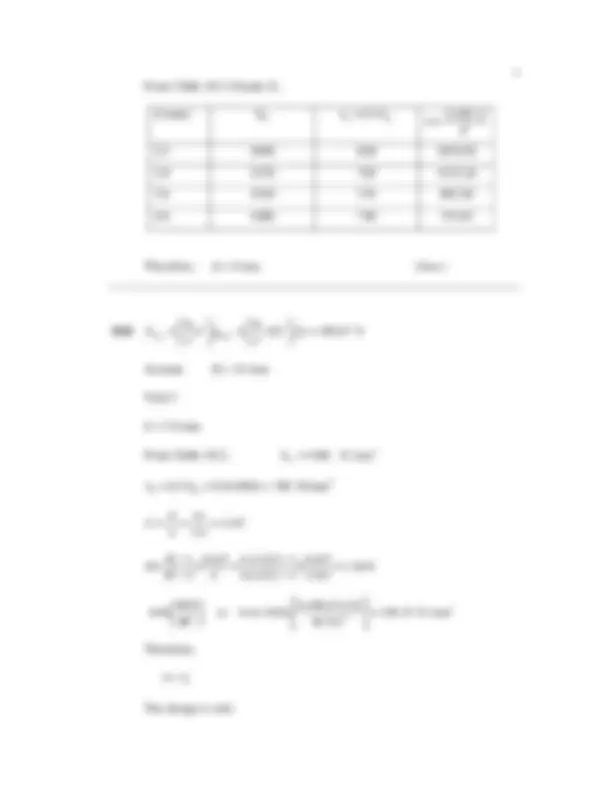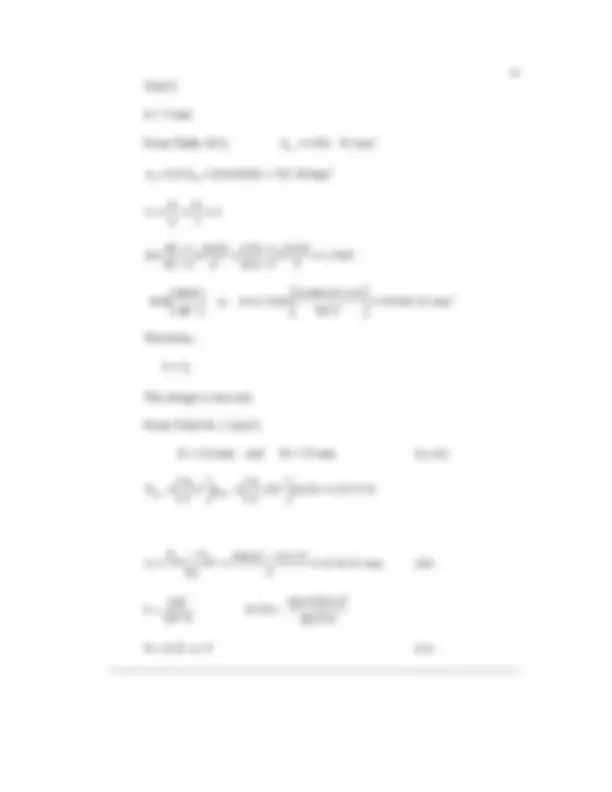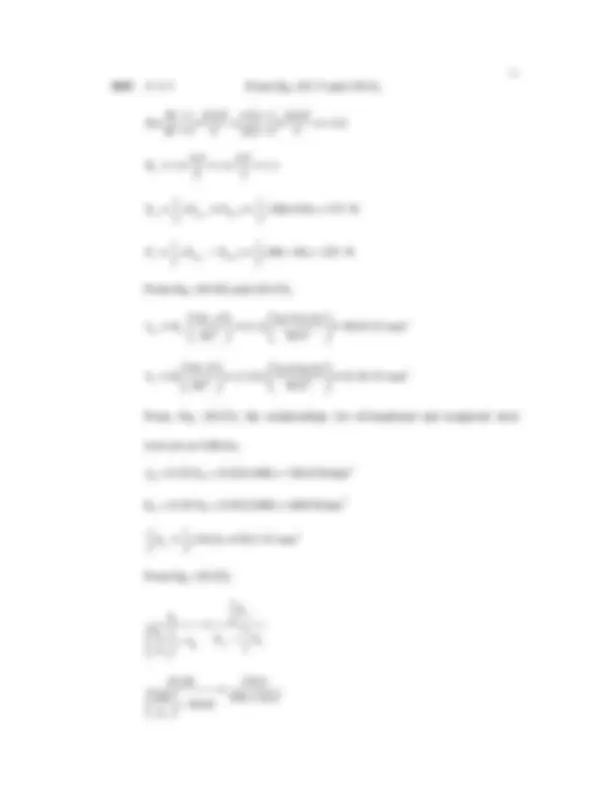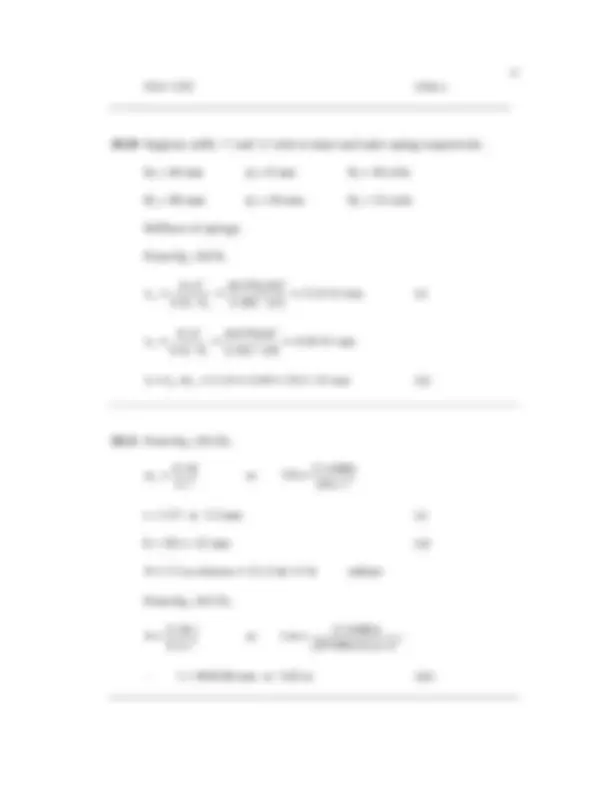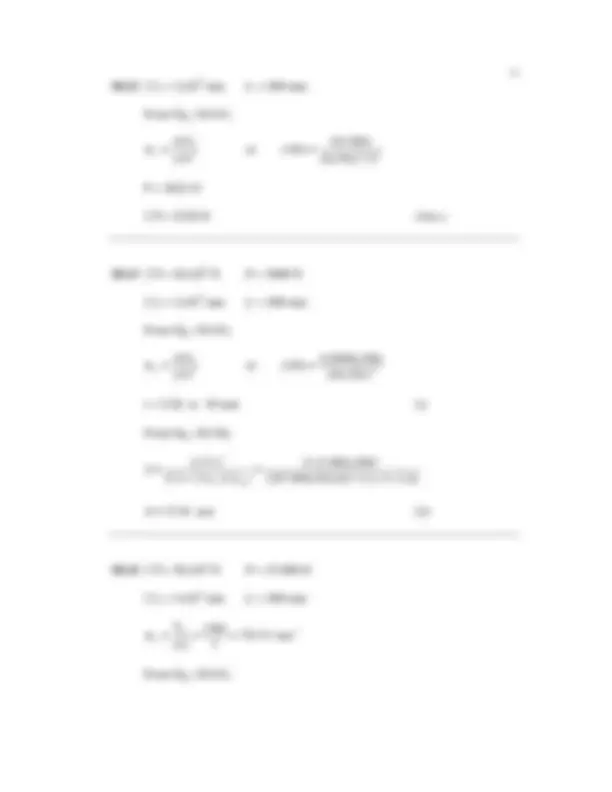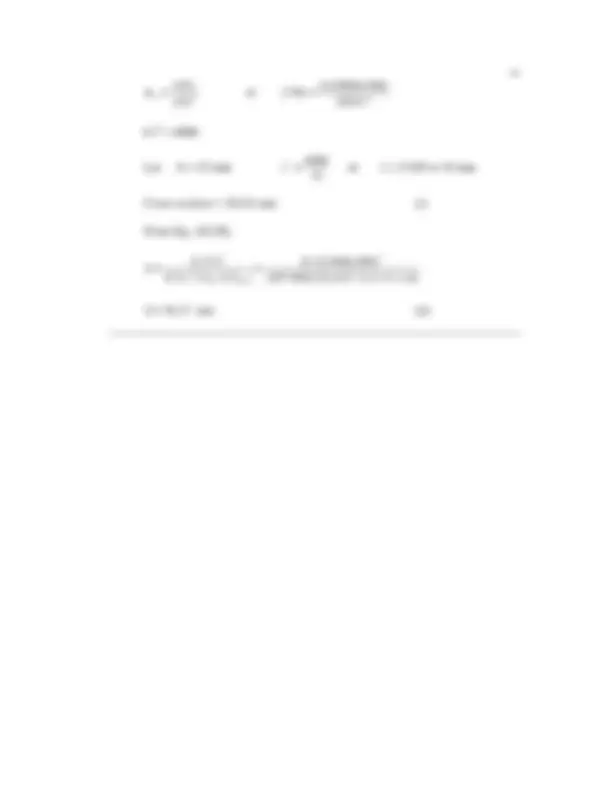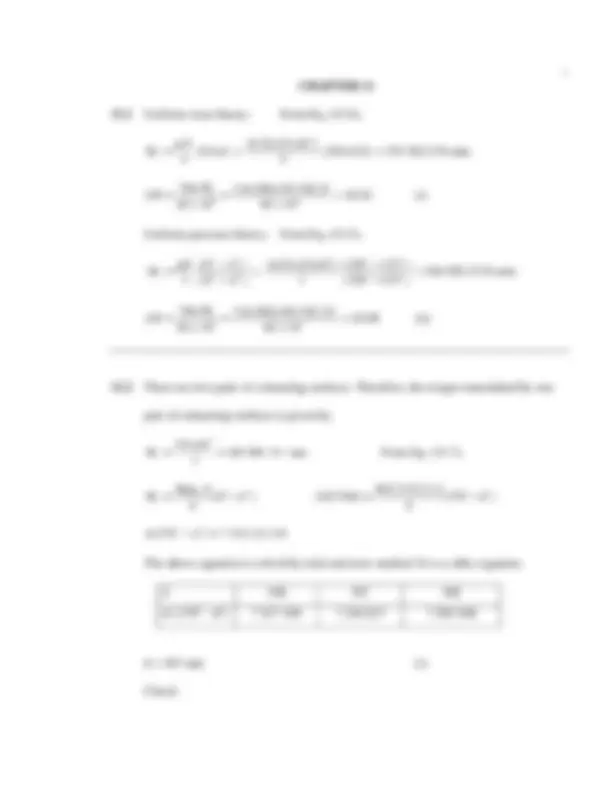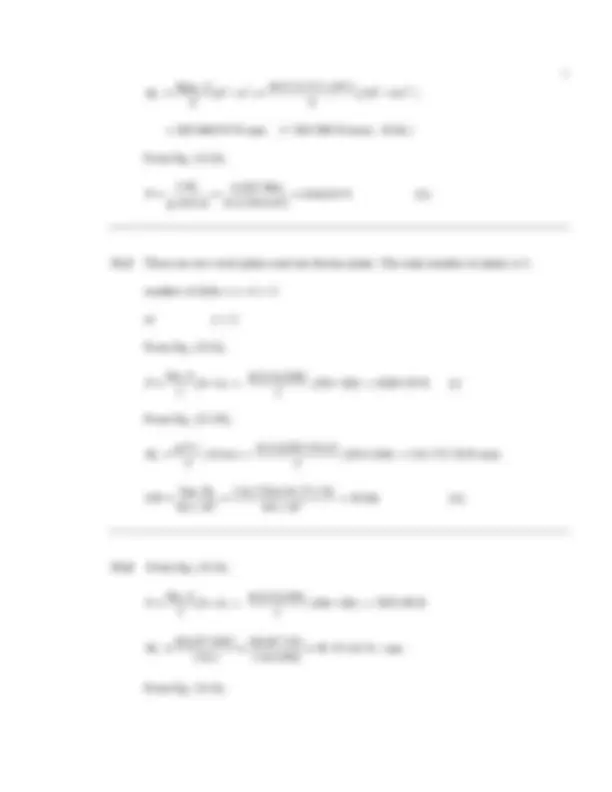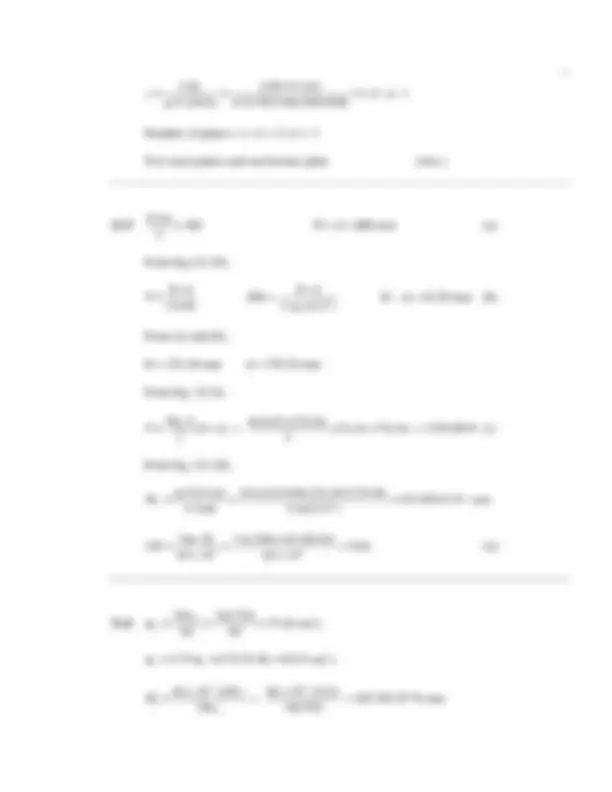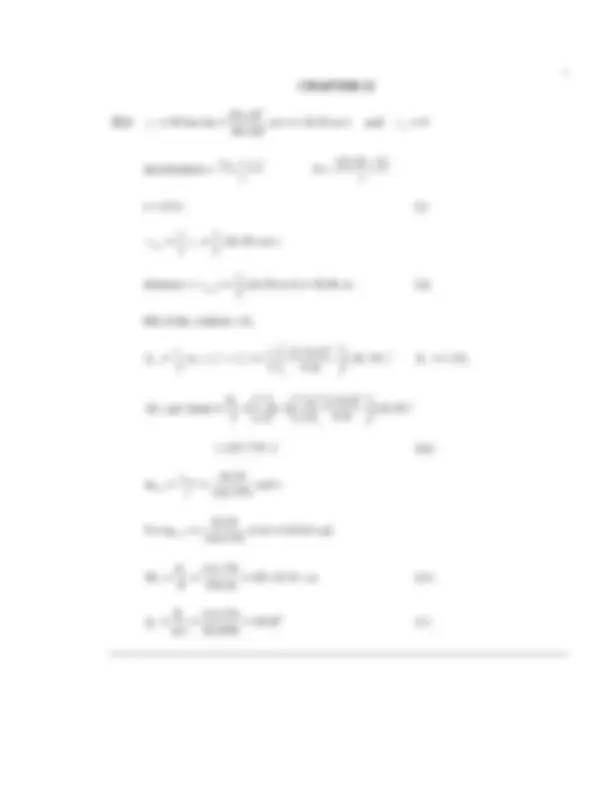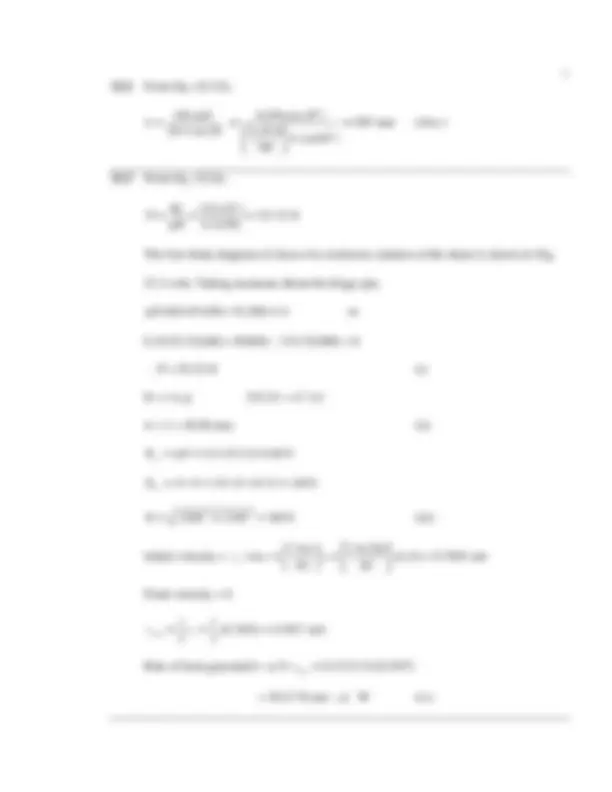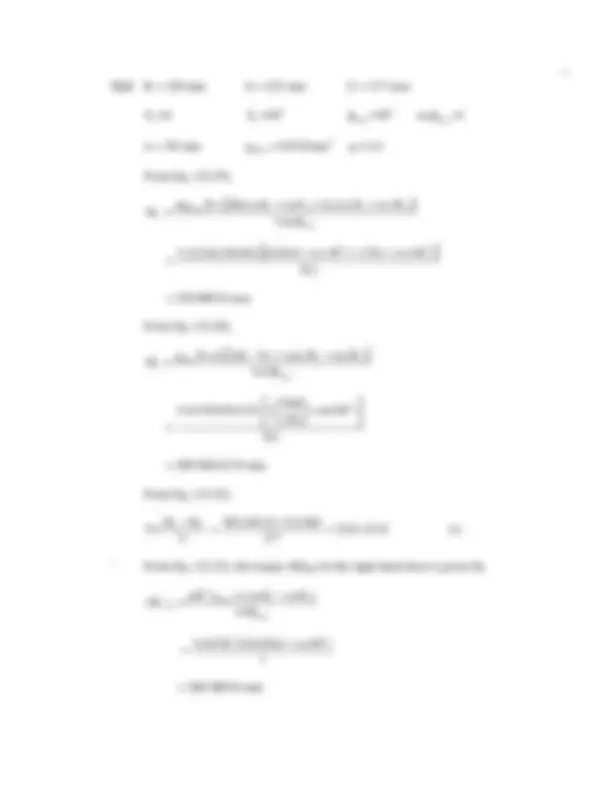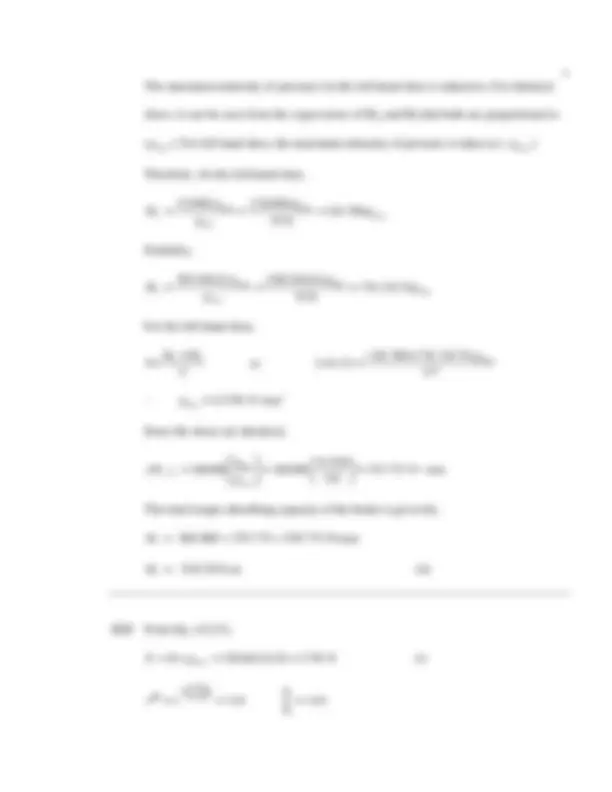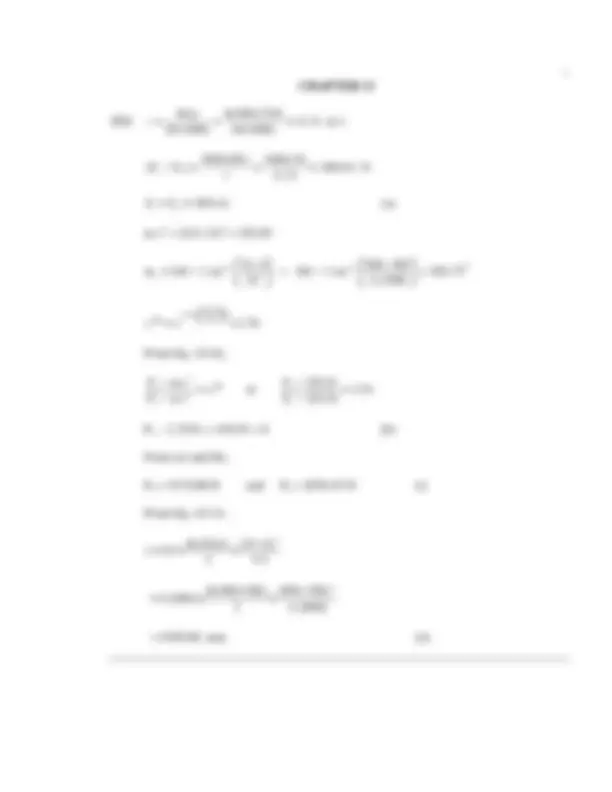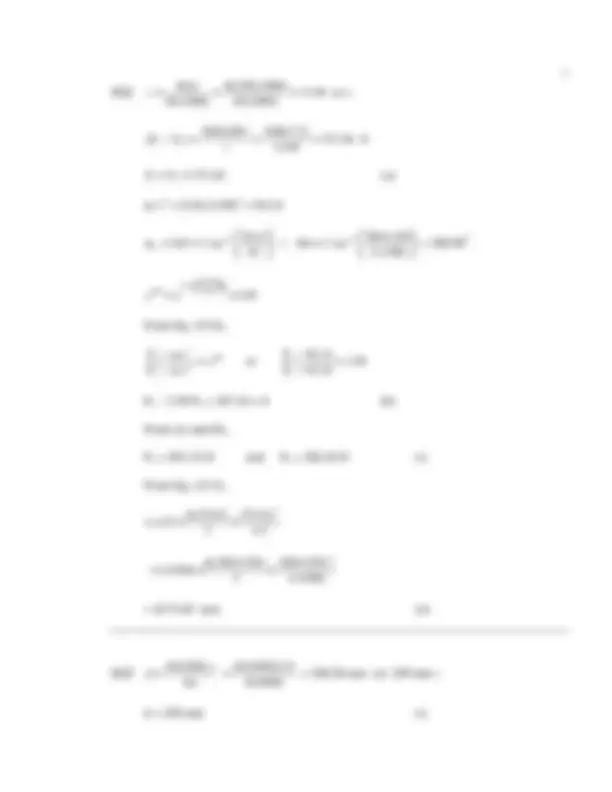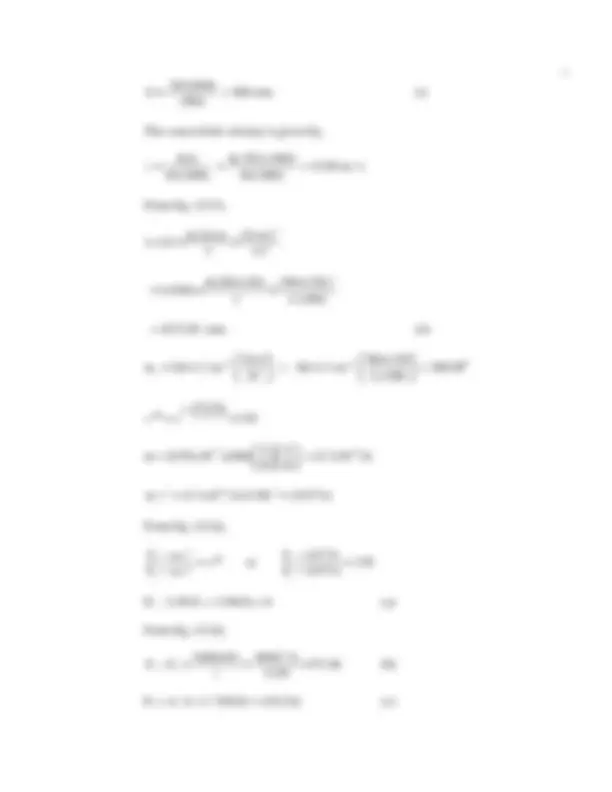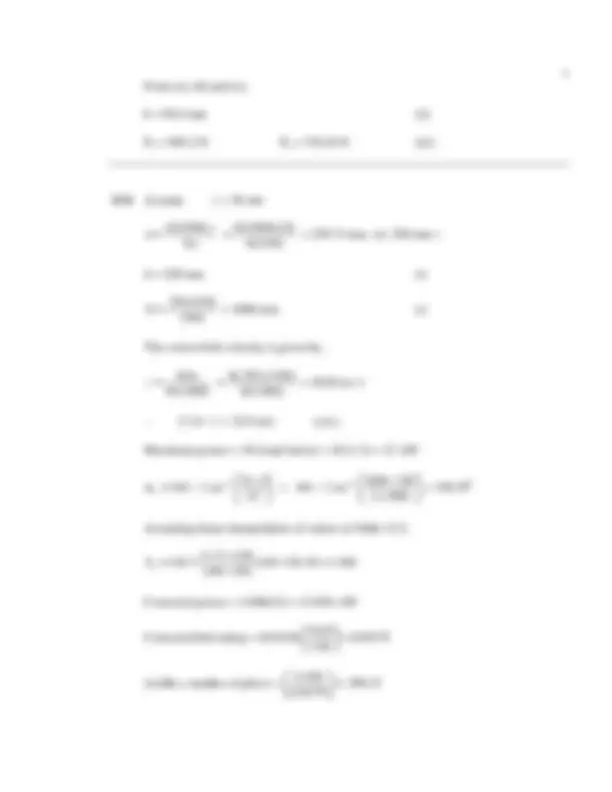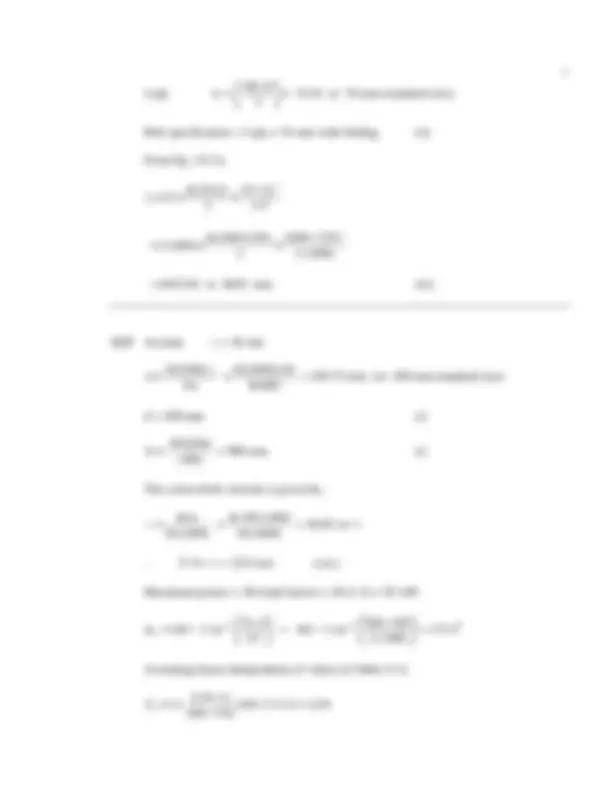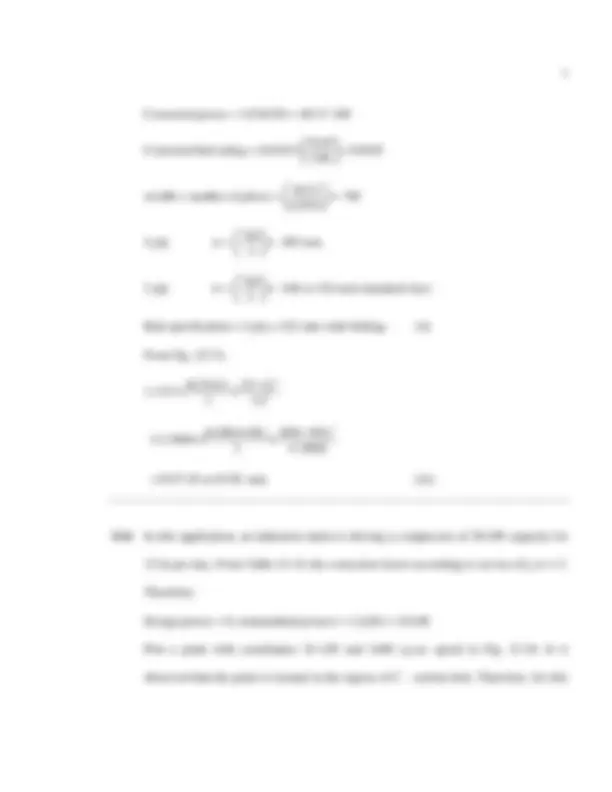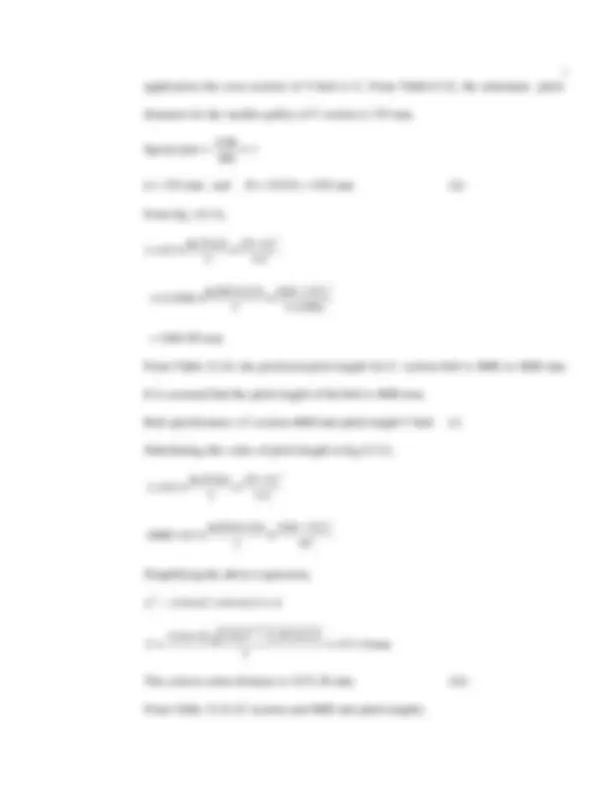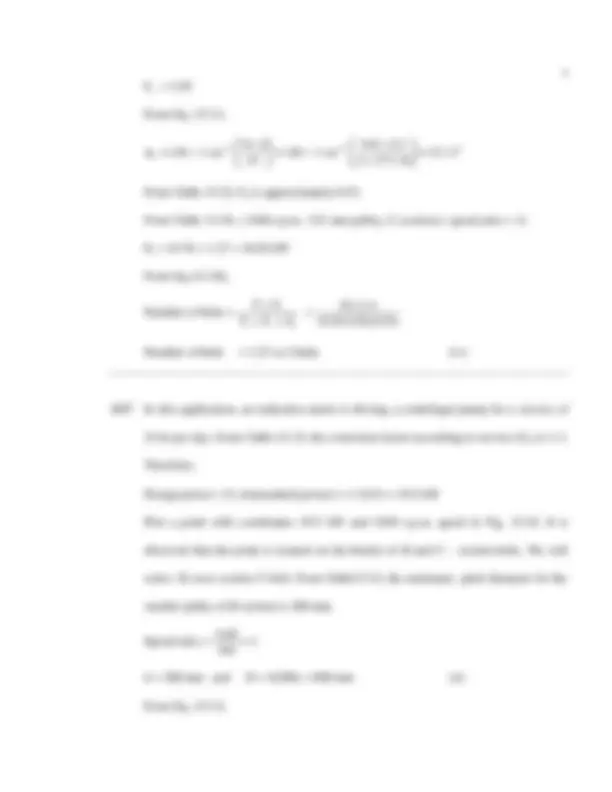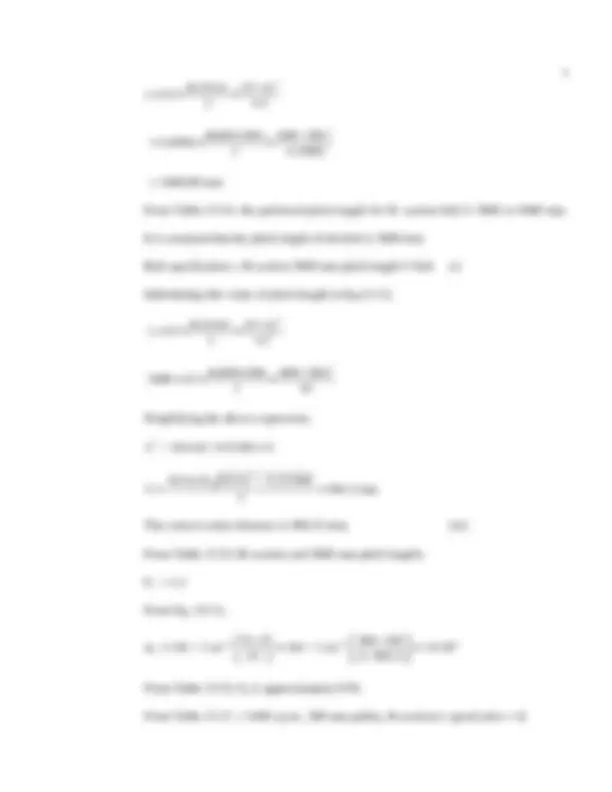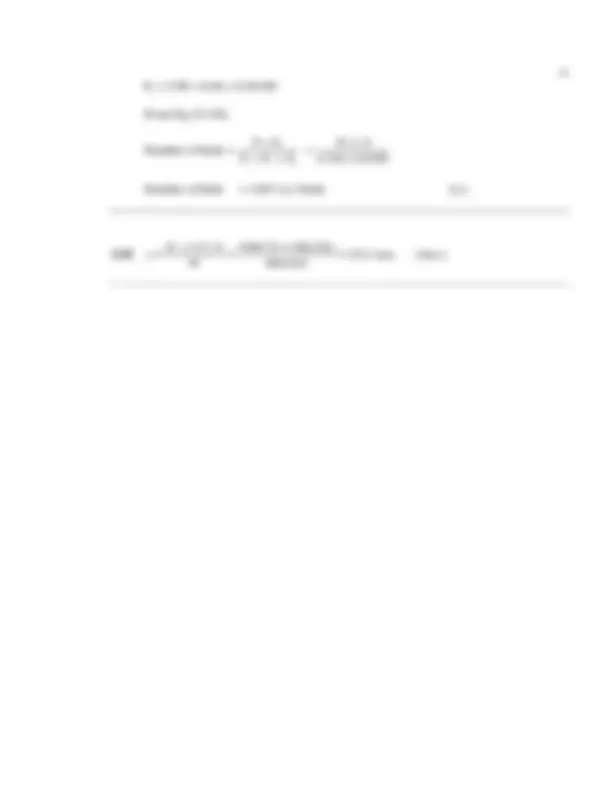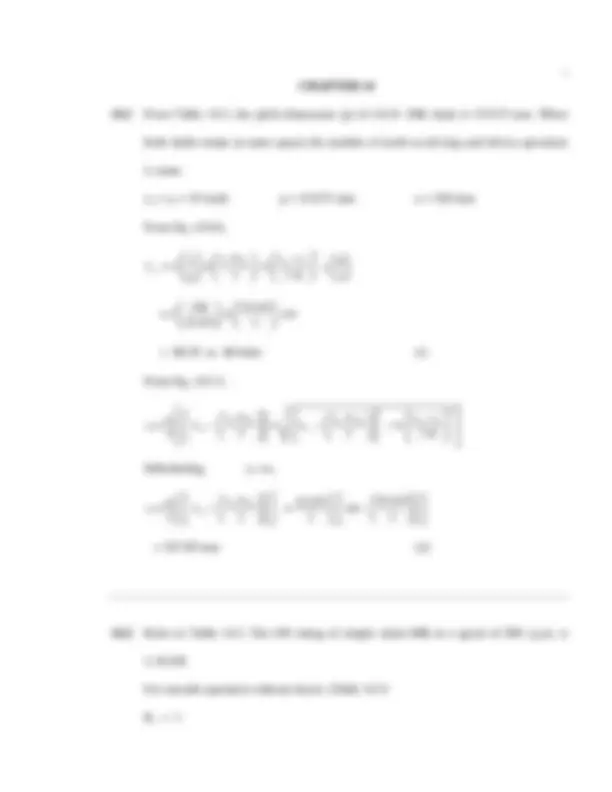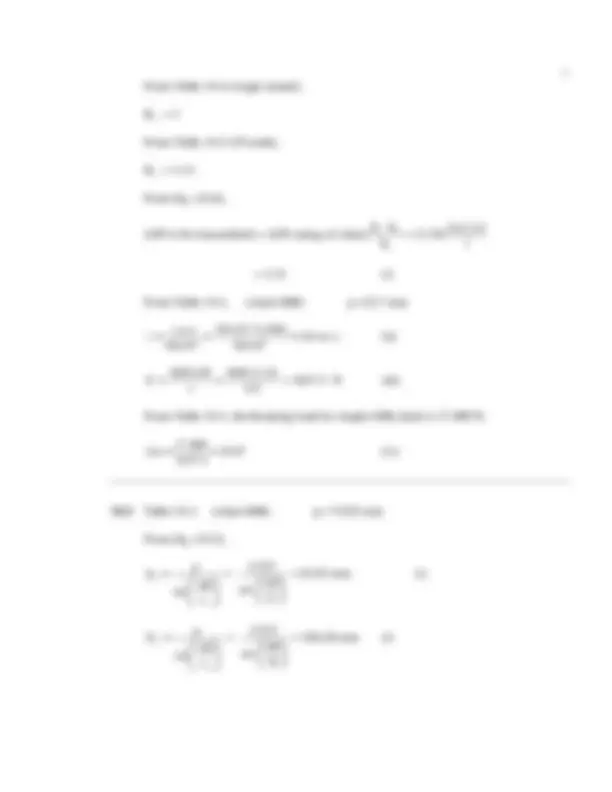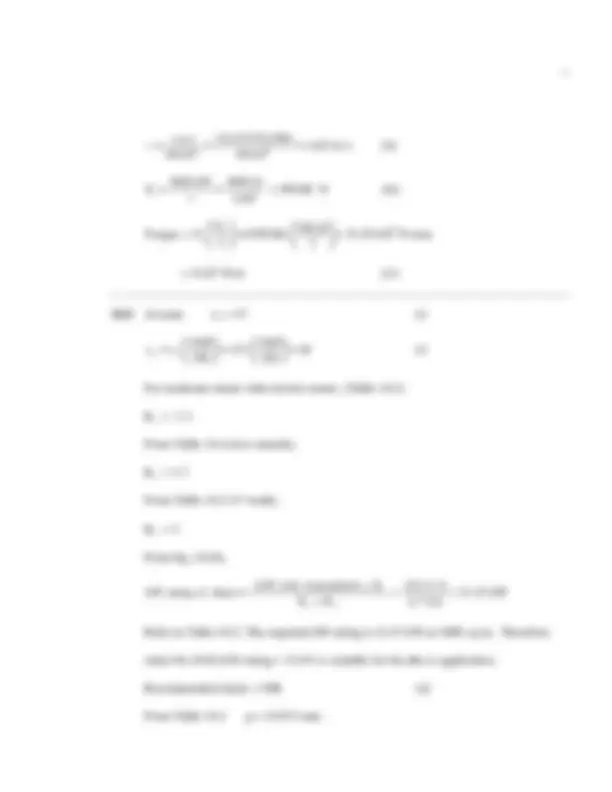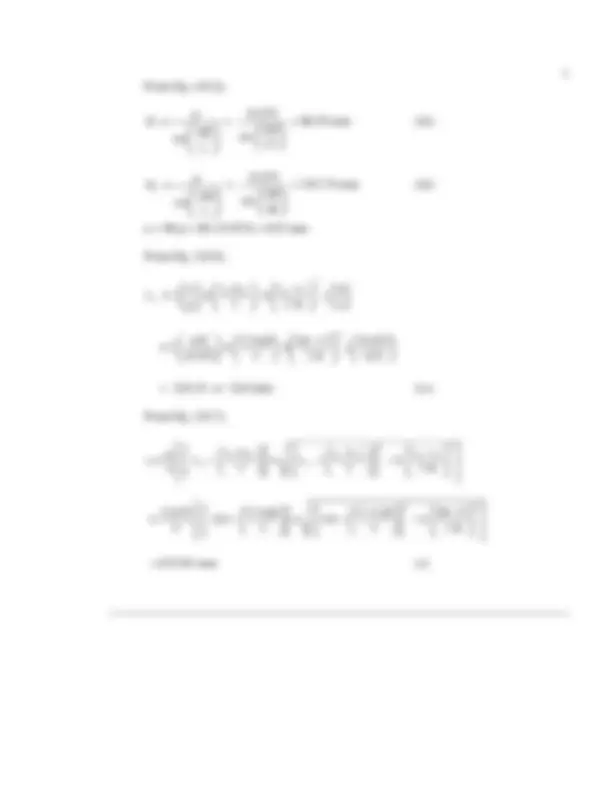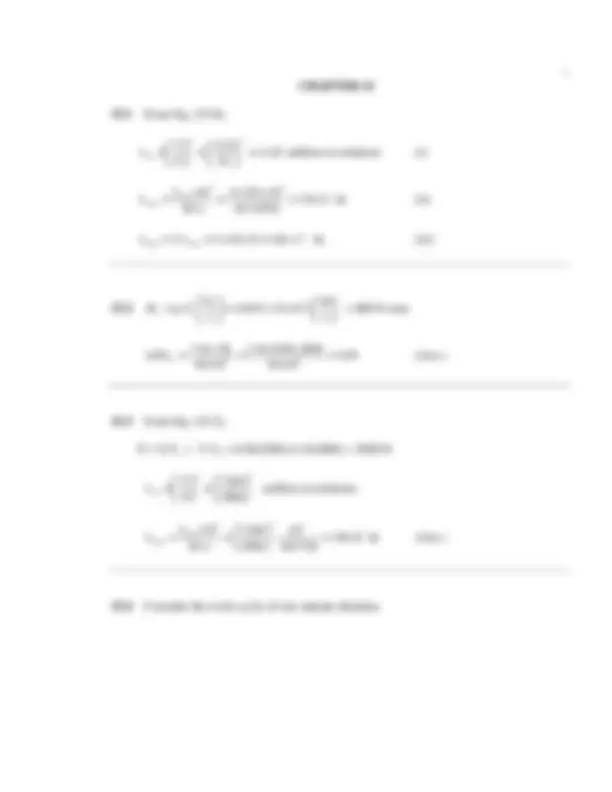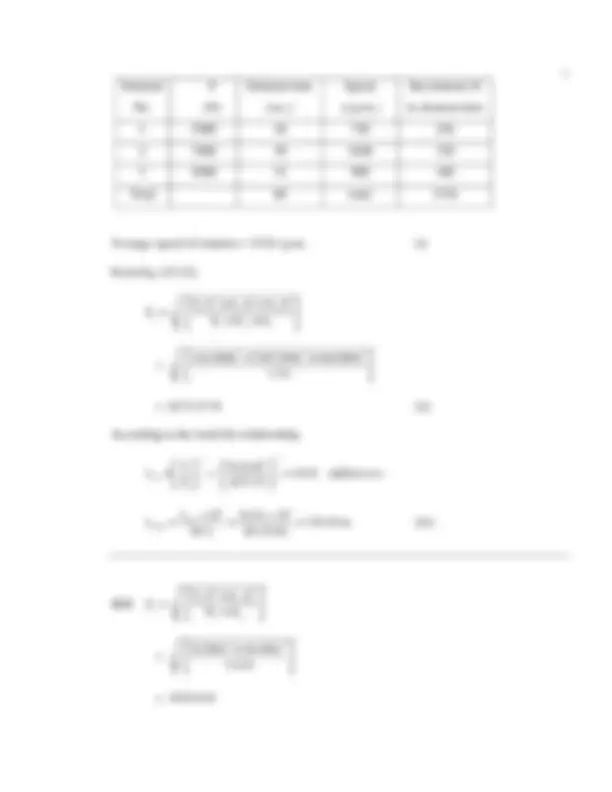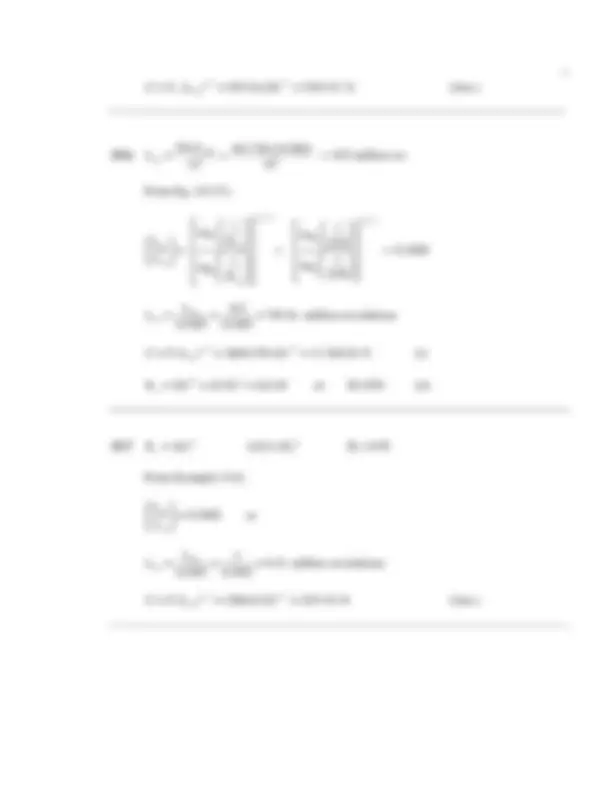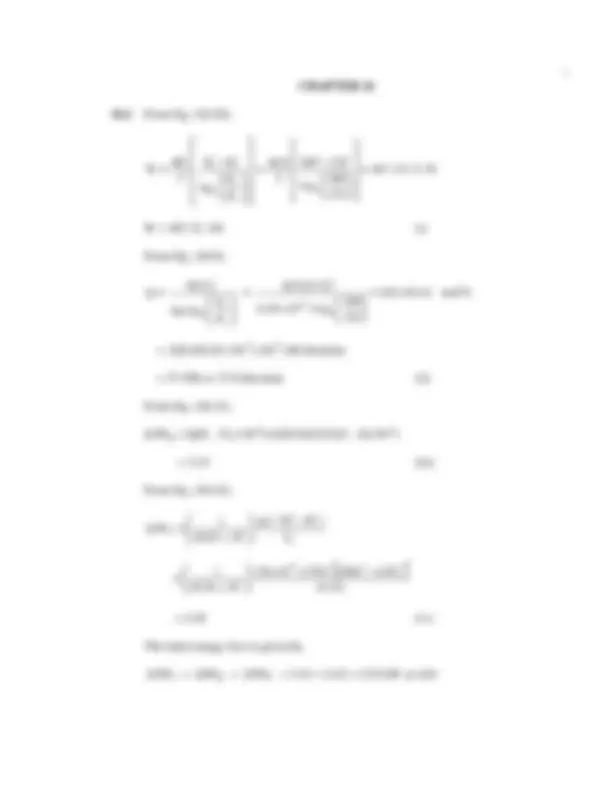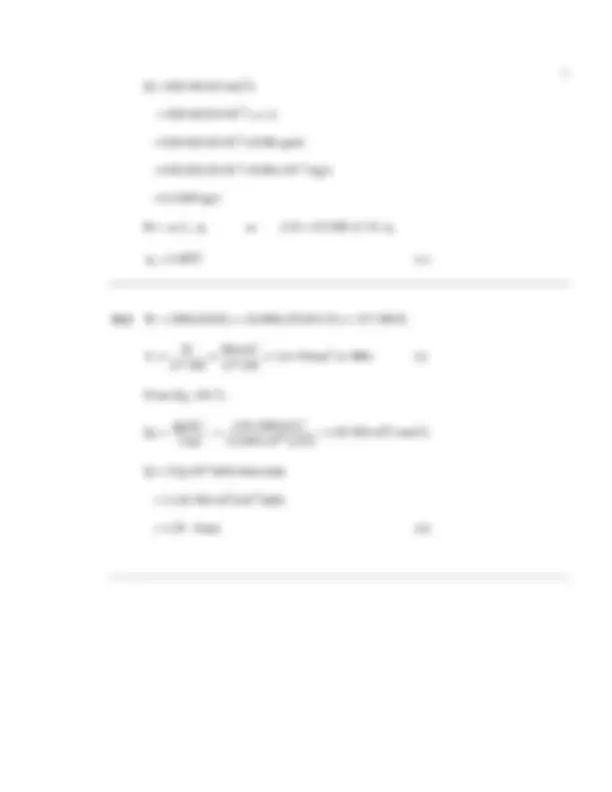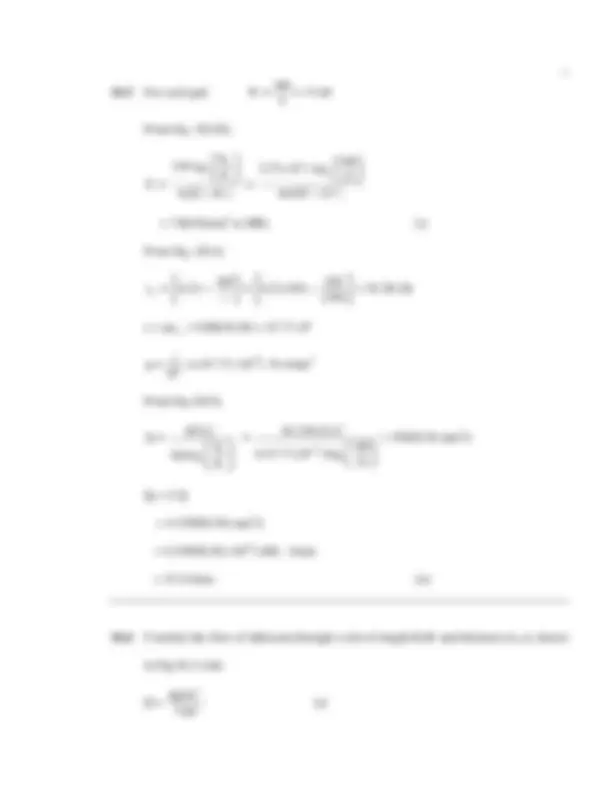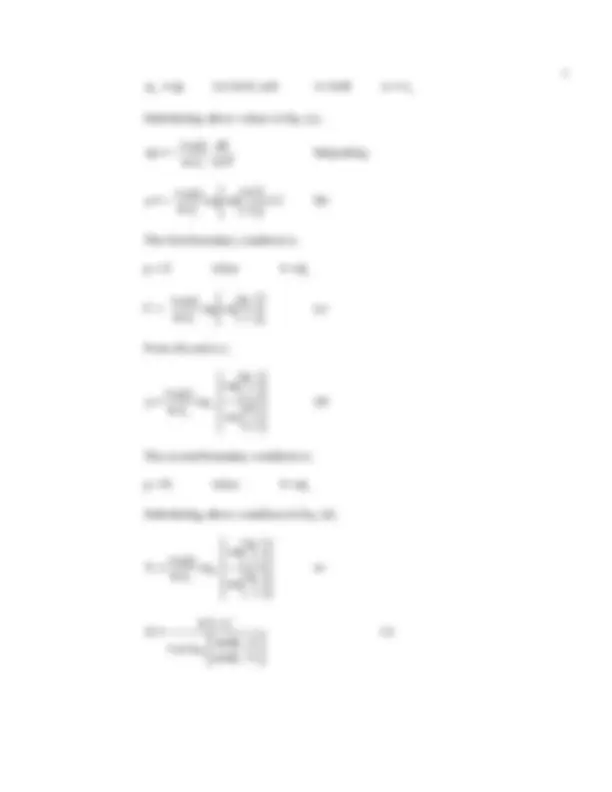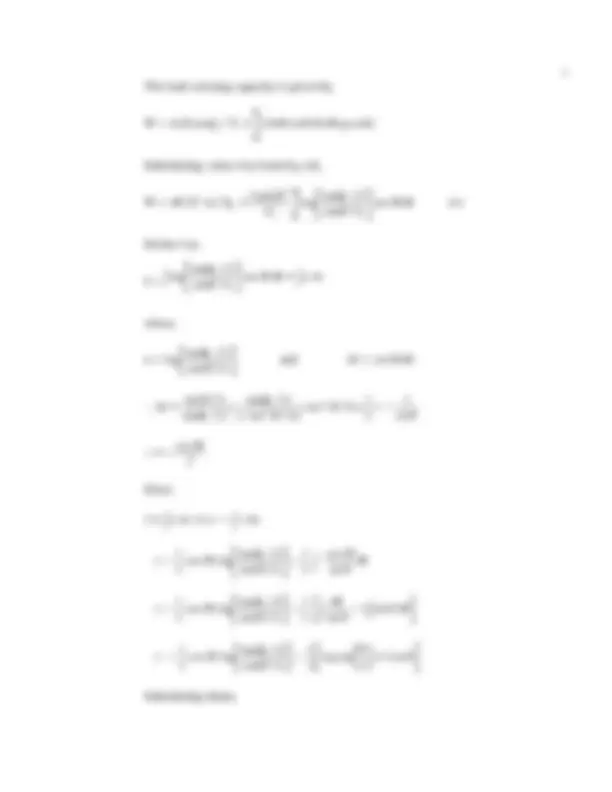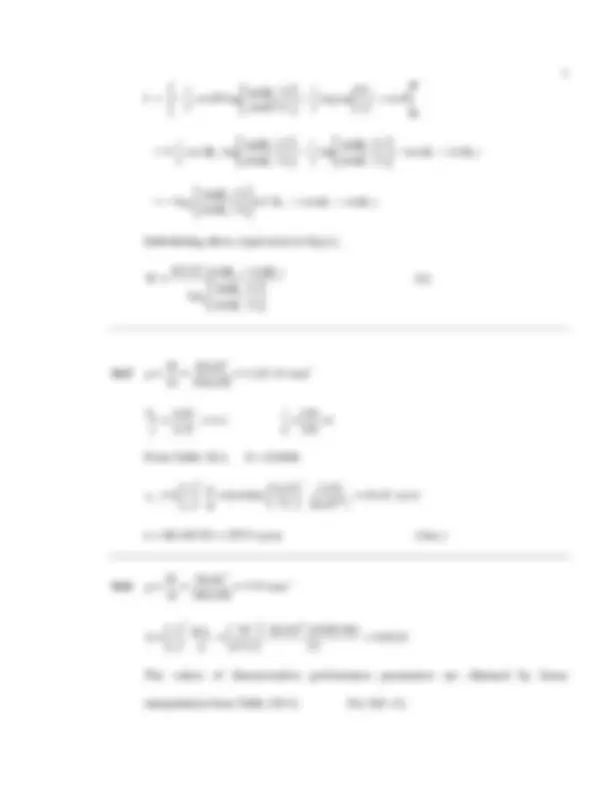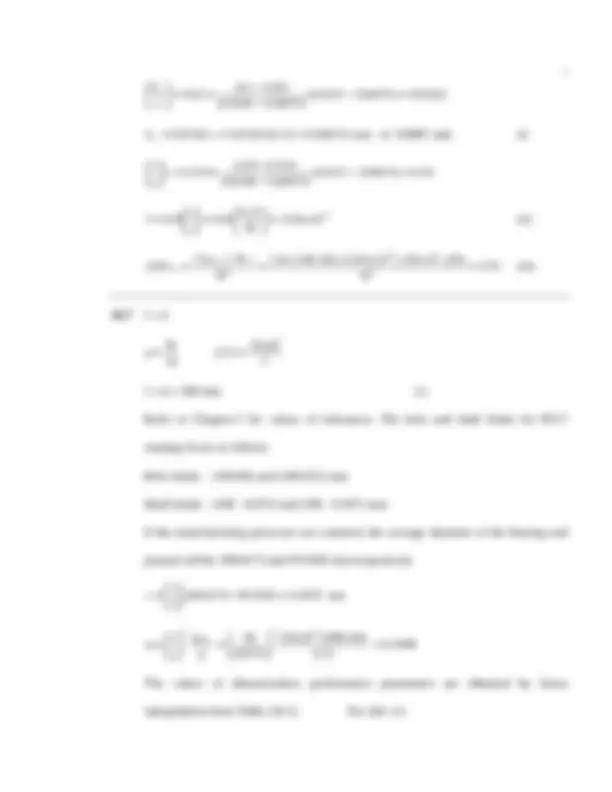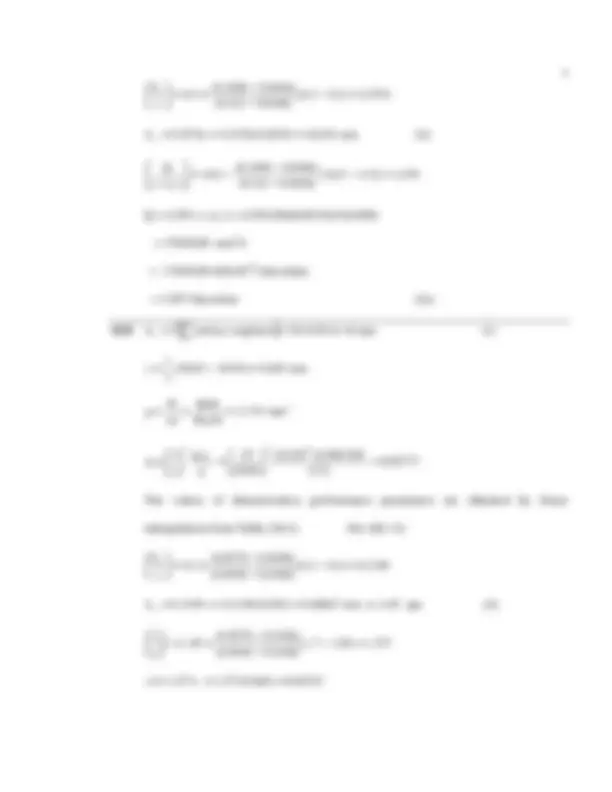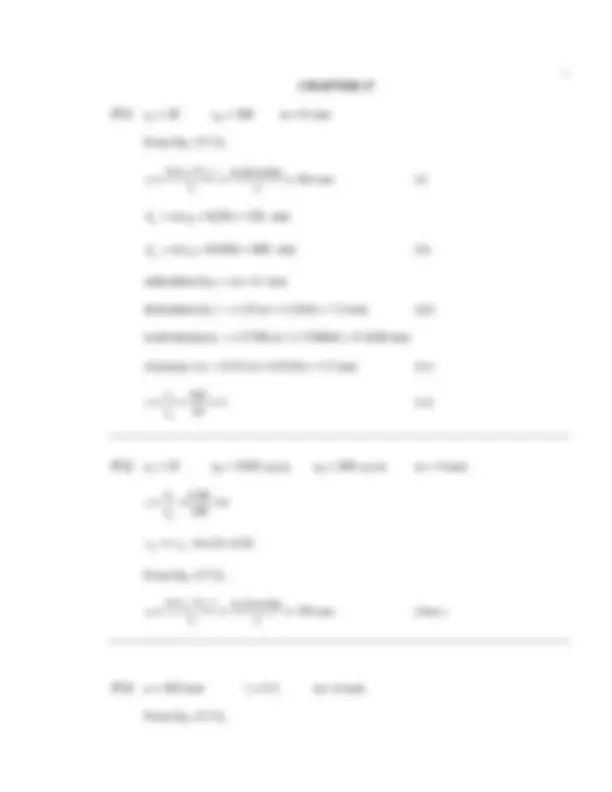Download Mechanical Design Analysis and more Study notes Mechanics of Materials in PDF only on Docsity!
Solutions Manual to
DESIGN OF MACHINE ELEMENTS
(First Revised Edition)
V. B. Bhandari
Formerly
Professor & Head of Mechanical Engineering
Vishwakarma Institute of Technology, Pune.
McGraw-Hill Education (India) Limited
New Delhi
CHAPTER 1
1.1 The series factor for R10 series is given by,
10
First number = 1
Second number = 1 ( 1. 2589 )= 1.2589 = (1.25)
Third number = (1.2589)( 1.2589) =
2
Fourth number = (1.2589)
2
3
Fifth number = (1.2589)
3
4
Sixth number = (1.2589)
4
5
Seventh number = (1.2589)
5
6
Eighth number = (1.2589)
6
7
Ninth number = (1.2589)
7
8
Tenth number = (1.2589)
8
9
Eleventh number = (1.2589)
9
10
In above calculations, the rounded numbers are shown in bracket.
The series factor for R20 series is given by,
Since every third term of R20 series is selected, the ratio factor ( φ ) is given by,
3 φ= =
First number = 200
Second number = 200 ( 1. 4125 )= 282.5 = (280)
0
1
2
3
4
5
6
7 72 (φ)
8
9
10 72 (φ)
The maximum speed is 720 r.p.m. Therefore,
10
72 (φ) = 720 or ( 10 ) 10 1. 2589
1 / 10
⎟ = =^ = ⎠
φ=
Speed of first step = 72 r.p.m.
Speed of second step = 72 ( 1. 2589 )= 90.64 = (91) r.p.m.
Speed of third step = 72
2
( 1. 2589 ) = 114.11 = (114) r.p.m.
Speed of fourth step = 72
3
( 1. 2589 ) = 143.65 = (144) r.p.m.
Speed of fifth step = 72
4
( 1. 2589 ) = 180.84 = (181) r.p.m.
Speed of sixth step = 72
5
( 1. 2589 ) = 227.66 = (228) r.p.m.
Speed of seventh step = 72
6
( 1. 2589 ) = 286.60 = (287) r.p.m.
Speed of eighth step = 72
7
( 1. 2589 )= 360.80 = (361) r.p.m.
Speed of ninth step = 72
8
( 1. 2589 ) = 454.22 = (454) r.p.m.
Speed of tenth step = 72
9
( 1. 2589 ) = 571.81 = (572) r.p.m.
Speed of eleventh step = 72
10
( 1. 2589 ) = 719.85 = (720) r.p.m.
CHAPTER 3
3.1 From Tables 3.2 and 3.3b, the tolerances for the small end of connecting rod and bush
are as follows:
Connecting rod (inner diameter) (15H6) =
mm
Bush (outer diameter) (15r5) =
mm
Maximum interference = 15.031 – 15 = 0.031 mm
Minimum interference = 15.023 - 15.011 = 0.012 mm
3.2 From Tables 3.2 and 3.3a,
Limiting dimensions of valve stem (5d8) =
mm
Limiting dimensions of guide for valve stem (7H7) =
mm
Maximum clearance = 5.012 - 4.952 = 0.06 mm
Minimum clearance = 5 - 4.97 = 0.03 mm
From Tables 3.2 and 3.3b,
Limiting dimensions of valve seat (20s5) =
mm
Limiting dimensions of housing (20H6) =
mm
Maximum interference = 20.044 – 20 = 0.044mm
Minimum interference = 20.035 – 20.013 = 0.022 mm
yt 2 t 83.^3 N/mm 3
(fs)
S
σ = = =
t
2 dr 4
P (^) ⎟σ ⎠
⎛ π
= or d 83. 3
2 r ⎟ ⎠
⎛ π
= dr = 34.96 mm (i)
Diameter of pin:
sy yt 2
- 67 N/mm 3
(fs)
0. 5 S
(fs)
S
τ= = = =
⎟^ τ ⎠
⎛ π
2 dp 4
P 2 ∴ d ( 41. 67 ) 4
2 p ⎟ ⎠
⎛ π
= dp = 34.96 mm (ii)
ut 2 t 120 N/mm
- 5
(fs)
S
σ = = =
2 2 N/mm t
(t)( 5 t)
A
P
2 2 3
N/mm t
(t)( 5 t) 12
15000 ( 7. 5 t)( 2. 5 t)
I
P ey ⎟ ⎠
From Eq.(4.24),
I
Pey
A
P
σ t = + or ⎟
t
t
t
t = 15.81 mm (Ans.)
2 ( σ 1 −σ 2 )= 50 N/mm
2
( σ 1 −σ 3 )= 200 N/mm (Maximum value)
2 ( σ 2 −σ 3 )= 150 N/mm
Maximum shear stress theory: Eq.(4.39)
(fs)
S
yt
σ 1 −σ 3 = or
(fs)
( 200 )= (fs) = 2.3 (i)
Distortion energy theory: Eq.(4.44)
( )
2 1 2 2
2 1
yt
(fs)
S
= σ −σ σ +σ
2 2 ( 200 ) ( 200 )( 150 ) ( 150 ) (fs)
= − + (fs) = 2.55 (ii)
x y 2 70 N/mm 2
⎛ σ +σ
x y 2 30 N/mm 2
⎛ σ −σ
From Eqs. (4.31) and (4.32),
2 xy
2 x y x y 1 2 ( ) 2 2
, + τ ⎟
⎛ σ −σ ± ⎟
⎛ σ +σ σ σ =
2 2 = 70 ± ( 30 ) +( 80 )
2 σ 1 = 155. 44 N/mm
2 σ 2 =− 15. 44 N/mm σ 3 = 0
From Eq.(4.34),
2 xy
2 x y max ( ) 2
⎛ σ −σ τ =
2 2
= ( 30 ) +( 80 ) = 85.44 N/mm
2
Maximum normal stress theory:
S 380
(fs) 1
yt = = σ
= (i)
Maximum shear stress theory:
S 0. 5 S 0. 5 ( 380 )
(fs) max
yt
max
sy = = τ
τ
= (ii)
Distortion energy theory: Eq.(4.44)
( ) [ ]
2 2 2 2 1 2 2
2 σ 1 −σ σ +σ = ( 155. 44 ) −( 155. 44 )(− 15. 44 )+(− 15. 44 ) = 163. 71 N/mm
Ro = 10 t bo = 4 t t i =to=t
From Eq. (4.64),
[ ]
10 t t
10 t 4 tlog 4 t t
10 t t tlog 4 t
4 t t 4 tlog
t( 4 t t) t( 4 t t) t( 6 t) R
e e e
N = (6.3098 t) mm
e =R−RN =( 7 − 6. 3098 )t=( 0. 6902 t)mm
h (^) i =RN−Ri=( 6. 3098 − 4 )t=( 2. 3098 t) mm
M ( 100 x 10 )( 4 t R) ( 100 x 10 )( 4 t 7 t) ( 11 x 10 )t N mm
3 3 5 b = + = + = −
2 2 2 2 2 A = 4 t + 4 t + 4 t =( 12 t )mm
From Eq.(4.56),
2 2
5
2
5
i
b i bi N/mm 12 t
- 2031 x 10
( 12 t )( 0. 6902 t)( 4 t)
( 11 x 10 t)( 2. 3098 t)
AeR
M h ⎟
σ = = =
Direct tensile stress:
2 2
5
2
3
t N/mm 12 t
( 12 t )
100 x 10
A
P
σ = = =
2
5
2
5
i
ut b i 12 t
- 2031 x 10
12 t
AeR
M h
A
P
(fs)
S
t = 26.62 mm (Ans.)
4.9 Permissible stresses: -
yt 2 t 60 N/mm 5
(fs)
S
σ = = =
sy yt 2 30 N/mm 5
- 5 x 300
(fs)
0. 5 S
(fs)
S
τ= = = =
Refer to Fig.4.1-solu, ( 7. 5 x 10 )x 100 Px 500
3
= or P = 1500 N
2 2
R = ( 7500 ) +( 1500 ) = 7648.53 N From Eq.(4.51),
R = p ( d x l ) or 7648.53 = 10 ( d x 1.5 d )
∴ d = 22. 58 mm and l= 1. 5 d= 1. 5 x 22. 58 = 33. 87 mm ( i )
2
2 2
- 55 N/mm
( 22. 58 ) 4
d 4
R
⎛ π
⎛ π
τ = ( ii )
The dimensions of the boss of lever at the fulcrum are as follows,
inner diameter = 23 mm, outer diameter = 46 mm, length = 34 mm ( iii )
For the lever, d = 4 b Mb = ( 7500 x 100 ) N- mm
I
M (^) by
σb = or 60 =
b( 4 b) 12
( 7500 x 100 )( 2 b)
∴ b = 16.74 mm d = 4 b = 4 x 16.74 = 66.94 mm ( iv )
yt 2 t 50 N/mm 4
(fs)
S
σ = = =
Components of force P :-
Pv = P cos ( 30 ) = 5000 cos ( 30 ) = 4330.13 N
Ph = P sin ( 30 ) = 5000 sin ( 30 ) = 2500 N
Mb = Ph x 250 + Pv x 125 = 2500 x 250 +4330.13 x 125 = 1166 266.25 N-mm
I
M (^) by
σb = =
t( 2 t) 12
1166 266. 25 xt
3
t
- 4 x 10
N / mm
2
( i )
2 2
V t t
2 t
A
P
σ = = = N / mm
2
( ii )
3 2
3
t
t
- 4 x 10
∴ 50 = + or t
3
CHAPTER 5
5.1 At the hole of 3 mm diameter,
2
3
o 60.^61 N/mm ( 25 3 ) 15
20 x 10
(w d)t
P
σ =
w
d ⎟= ⎠
From Fig.5.2, K t = 2. 67
2
σ max =K tσo = 2. 67 ( 60. 61 )= 161. 82 N/mm (i)
At the hole of 5 mm diameter,
2
3
o 66.^67 N/mm ( 25 5 ) 15
20 x 10
(w d)t
P
σ =
w
d ⎟= ⎠
From Fig.5.2, K t = 2. 51
2
σ max =K tσo = 2. 51 ( 66. 67 )= 167. 33 N/mm (ii)
At the hole of 10 mm diameter,
2
3
o 88.^89 N/mm ( 25 10 ) 15
20 x 10
(w d)t
P
σ =
w
d ⎟= ⎠
From Fig.5.2, K t = 2. 25
2
σ max =K tσo = 2. 25 ( 88. 89 )= 200 N/mm (iii)
5.2 D = 0.25d +d +0.25 d = 1.5 d 1. 5
d
D
From Fig.5.5, (D/d = 1.5 and Kt = 1.5 )
d
r ⎟= ⎠
- 76 mm
- 17
r
d = = = (i)
2 3
3
3
b b 93.^94 N/mm ( 11. 76 )
32 ( 15 x 10 )
d
32 M
π
π
σ =
2
σ max =K tσo = 1. 5 ( 93. 94 )= 140. 91 N/mm (ii)
S 200
(fs) max
ut (^) = = σ
= (iii)
5.3 By symmetry, the reaction at each bearing is 2500 N. At fillet section,
M (^) b = 2500 ( 25 )= 62500 N−mm
2 3 3
b b 9.^947 N/mm ( 40 )
d
32 M
π
π
σ =
d
D
and 0. 05
d
r ⎟= = ⎠
From Fig.5.5, K t = 2. 05
2
σ max =K tσo = 2. 05 ( 9. 947 )= 20. 39 N/mm (Ans.)
ut^2 max 140 N/mm
- 5
(fs)
S
σ = = =
2
3
o 66.^67 N/mm ( 30 )( 10 )
20 x 10
dt
P
σ = = =
K
o
max t = = σ
σ
= and 1. 5
d
D
From Fig.5.3, (D/d = 1.5 and Kt = 2.1 )
d
r ⎟= ⎠
r = 0.095 d = 0.095 (30) = 2.85 or 3 mm (Ans.)
K (^) f = 1 +q(Kt− 1 )= 1 + 0. 9 ( 1. 72 − 1 )= 1. 648
K
K
f
d = = =
' 2 Se =KaKbKdSe= 0. 78 ( 0. 85 )( 0. 61 )( 270 )= 109. 20 N/mm
e 2 b 54.^6 N/mm 2
(fs)
S
σ = = =
3
b b d
32 M
π
σ = or 3
3
d
32 ( 5 x 10 )( 100 )
- 6 π
= d = 45.35 mm (Ans.)
2 ut
' Se = 0. 5 S = 0. 5 ( 620 )= 310 N/mm
From Fig. 5.24 (Ground surface), K a = 0. 89
Assuming (7.5< d <50 mm), K b = 0. 85
For 90% reliability, K c = 0. 897
' 2 Se =KaKbKcSe = 0. 89 ( 0. 85 )( 0. 897 )( 310 )= 210. 36 N/mm
2 Sse = 0. 577 Se= 0. 577 ( 210. 36 )= 121. 38 N/mm
se^2 a 60.^69 N/mm 2
(fs)
S
τ = = =
(M (^) t )max= 400 N− m (M (^) t )min =− 200 N−m
[ ] [( 400 ) ( 200 )] 300 N m 2
(M) (M)
(M (^) t )a= t max − t min = − − = −
3
t a a d
16 (M )
π
τ = or (^3)
3
d
16 ( 300 x 10 )
- 69 π
= d = 29.31 mm (Ans.)
2 xym 17.^5 N/mm 2
τ =
2 xya 17.^5 N/mm 2
τ =
2 xm 7.^5 N/mm 2
σ =
2 xa 22.^5 N/mm 2
σ =
From Eqs. (5.50) and (5.51),
2 2 2 2 xym
2 σm = ( σxm) + 3 (τ ) = ( 7. 5 ) + 3 ( 17. 5 ) = 31. 22 N/mm
2 2 2 2 xya
2 σa = ( σxa) + 3 (τ ) = ( 22. 5 ) + 3 ( 17. 5 ) = 37. 75 N/mm
tan m
a (^) = = σ
σ θ = or
0 θ= 50. 4
The modified Goodman diagram is shown in Fig.5.1-solu.
X is the point of intersection of following two lines,
S
S (^) m a
+ = and 1. 2
S
S
m
a (^) =
2
Sa = 152. 83 N/mm and
2 S (^) m = 127. 36 N/mm
S 152. 83
(fs) a
a (^) = = σ
= (Ans.)
2 τ (^) xym = 70 N/mm
2 τxya = 35 N/mm
2 σ (^) xm = 60 N/mm
2 σxa = 80 N/mm
From Eqs. (5.50) and (5.51),
2 2 2 2 xym
2 σm = ( σxm) + 3 (τ ) = ( 60 ) + 3 ( 70 ) = 135. 28 N/mm
2 2 2 2 xya
2 σa = ( σxa) + 3 (τ ) = ( 80 ) + 3 ( 35 ) = 100. 37 N/mm
tan m
a (^) = = σ
σ θ = or
0 θ= 36. 57
CHAPTER 6
6.1 l = 2p = 2 x 6 = 12 mm
d m = d – 0.5p = 30 – 0.5 x 6 = 27 mm
d
l
tan
m
α = or
0
tan φ =μ= 0. 1 or
0
For square threads, Eq.(6.10)
tan( 5. 711 8. 052 )
tan( )
tan
η = or η = 57. 76 % ( i )
For Acme threads,
cos( 14. 5 )
cos
sec = =
μ θ= From Eq. (6.16),
0. 1415 ( 1 0. 10329 x 0. 1415 )
( sec tan )
tan ( 1 sec tan )
∴ η= 56. 96 % ( ii )
6.2 l = p = 6 mm d m = d – 0.5p = 36 – 0.5 x 6 = 33 mm
d
l
tan
m π
α = or
0
tan φ =μ= 0. 15 or
0
tan( 8. 531 3. 312 )
( 10 x 10 )( 33 )
tan( )
Wd
M
3 m
t =^ φ+α = + = 34 599.55 N-mm
( 0. 2 )( 10 x 10 )( 50 30 )
W(D D)
M )
3 c o i t c
= = 40 000 N-mm
( Mt )t= 34 599.55 + 40 000 = 74 599.55 N-mm or 74.6 N – m ( i )
( 10 x 10 )( 6 )
2 (M )
W l
3
t t
o =
η = or 12.8 % ( ii )
6.3 l = 2p = 2 x 9 = 18 mm
d m = d – 0.5p = 60 – 0.5 x 9 = 55.5 mm
d
l
tan
m
α = or
0
0
cos( 14. 5 )
μsec θ= =
Raising load : From Eq.(6.13),
( 1 sec tan )
( sec tan )
x
Wd
M
m t
( 1 0. 1549 x 0. 1032 )
x
( 5 x 10 )( 55. 5 )
3
= 36 393.14 N-mm or 36.39 N-m ( i )
Lowering load : From Eq.(6.15),
( 1 sec tan )
( sec tan )
x
Wd
M
m t
( 1 0. 1549 x 0. 1032 )
x
( 5 x 10 )( 55. 5 )
3
= 7060.51 N-mm or 7.06 N-m ( ii )
From Eq.(6.16),
0. 1032 ( 1 0. 1549 x 0. 1032 )
( sec tan )
tan ( 1 sec tan )
∴ η= 39. 35 % ( iii )
6.4 d c = d−p= 60 − 9 = 51 mm From Eq.(6.23),
6. 37 or 7
4 ( 50 x 10 )
S (d d )
4 W
z 22
3
2 c
2 b
= threads
length of nut = 7 x 9 = 63 mm (i)
t = p/2 = 9/2 = 4.5 mm From Eq.(6.22),

